The 7 Best Portable Water Purifiers For Travel (Complete Buyer's Guide)
.png)
Here at Twobirdsbreakingfree, we consider the subject of water to be extremely important when it comes to travel.
Many other travel websites have covered almost every travel topic under the sun but have written virtually nothing on the subject of water, which is quite surprising, considering that clean, safe drinking water is absolutely critical to our survival and well-being on the road.
Water is something we put into our bodies every single day, so it’s absolutely essential that the water we’re drinking is of the utmost purity and potability.
Even slightly impure water could contain cumulative toxins that could gradually build up in our bodies over time, causing long-term damage to our physical health.
Unfortunately, we cannot take clean water for granted anymore. The techno-industrial system that the world is addicted to has polluted the natural environment with myriad hazardous chemicals, heavy metals and other contaminants, and many of these harmful substances have found their way into our drinking water supplies.
In most populated parts of the world, we can no longer cup our hands and directly drink the water from a pond, creek, river or lake (no matter how clear the water is) without fear of falling sick shortly thereafter from some terrible viral, protozoan or bacterial pathogen like Giardia or E.coli.
Most of us are also aware that the piped water that comes from taps is often chlorinated or fluoridated, or both, and may also pass through old water pipes on its way to homes and business, where it can absorb heavy metals like copper and lead that have very harmful effects on the body when ingested.
And when we travel abroad, especially to developing countries with poor sanitation and even more suspect water supplies than those in highly developed countries, we find ourselves helplessly turning to branded bottled water, the only solution we know to the problem.
The solution
But the best solution to the problem of questionable municipal or local water supplies worldwide is not to buy imported bottled water.
This is the solution that most travellers seem to have chosen, but it is a very poor answer to the problem indeed.
Bottled water is not only thousands of times more expensive than piped tap water but also contributes to the massive global problem of growing non-biodegradable plastic waste.
We will eventually be buried under a mountain of our own self-produced plastic if we don’t do something to curb this environmental catastrophe.
And what many travellers don't realize is that bottled water isn’t even guaranteed to be safe to drink.
According to data from the Beverage Marketing Association, a trade group, 47% of all bottled water sold in the United States is just ordinary tap water that has been purified, packaged in fancy bottles and sold under a credible-sounding brand name.
In developing countries where bottled water is poorly regulated there can often be dozens of sketchy bottled water brands, and there’s a high likelihood that some of these are just repackaged tap water, which may not even have been purified.
A man in the town of Xinqiao, China was busted a while back after making $22,000 selling tap water to local residents under the pretense that he was selling them famous brands of bottled water like Nestle and Nongfu Spring. A month later two more men in Shanghai were arrested for the same scheme.
You have to ask yourself the question, if there are people being frequently caught for this scam, how many more schemes are there still operating that have not been detected by local authorities?
Reverse osmosis machines are appearing now in some countries as a much cheaper and more environmentally friendly alternative to bottled water (we’ve personally used them in Thailand and Malaysia), but they’re far from widespread.
What you really need to guarantee safe, clean drinking water at all times on the road is a personal, portable water purifier, that you can always carry with you on the road, no matter where you go.
In fact, carrying a portable water purification device is one of our top travel safety tips; once you know that access to safe drinking water is always guaranteed during your trip overseas, you'll have a lot less to worry about.
The only problem is that there are a lot of different water purifiers out there, all with varying pros and cons, so it can be difficult to decide which one to choose.
That’s why we’ve gone ahead and done all the hard work for you, fully reviewing and comparing the 7 best water portable purifiers for travel.
By the end of this article, you'll hopefully have gained enough confidence in at least one of these water purifiers to trust your life with it on the road!
No matter what your style of travel, we’re confident that you’ll find something here that will do the trick for you. So without further ado then, let's get started.
1. The Grayl UltralightWater Purifier
.jpg)
Specs
Dimensions: 9.625 x 2.875 inches (24.5 x 7.3 cm)
Weight: 10.9 oz (309 g)
Capacity: 16 oz (473 ml)
Colour: Black, blue, green, orange
Flow rate: 2L/min
Purification method(s): Mechanical, electro-adsorption, ultra-powdered activated carbon
Pore size: n/a
Removes: Viruses, bacteria, protozoa, chemicals, heavy metals, particulates
Filter lifespan: 40 gallons/151.416 L (approximately 300 uses)
Initial cost per litre: 40 cents
Recurring cost per litre: 17 cents
The first water purifier on our list is the popular Grayl Ultralight Water Purifier made by rainy Seattle-based company Grayl, Inc.
This latest offering from Grayl Inc. is the culmination of everything the company has learned since its beginnings in 2012.
The original Grayl water purifier was born from a kickstarter campaign inspired by two global travellers, Nancie Weston and Travis Merrigan, who wanted to find a solution to the mounting global problems of plastic waste and unsafe, poor quality drinking water. You can learn more about the company's origins and mission here.
Now the company has launched the Grayl Ultralight, a complete, all-in-one solution for filtering, purifying and carrying water on the go, whether you’re travelling internationally, backpacking, camping, fishing, hunting or hiking a gnarly trail in the wilderness.
The Grayl Ultralight was designed in the USA and the purifier that it uses is manufactured in the USA, while the Grayl ultralight bottle is made in China.
Product description
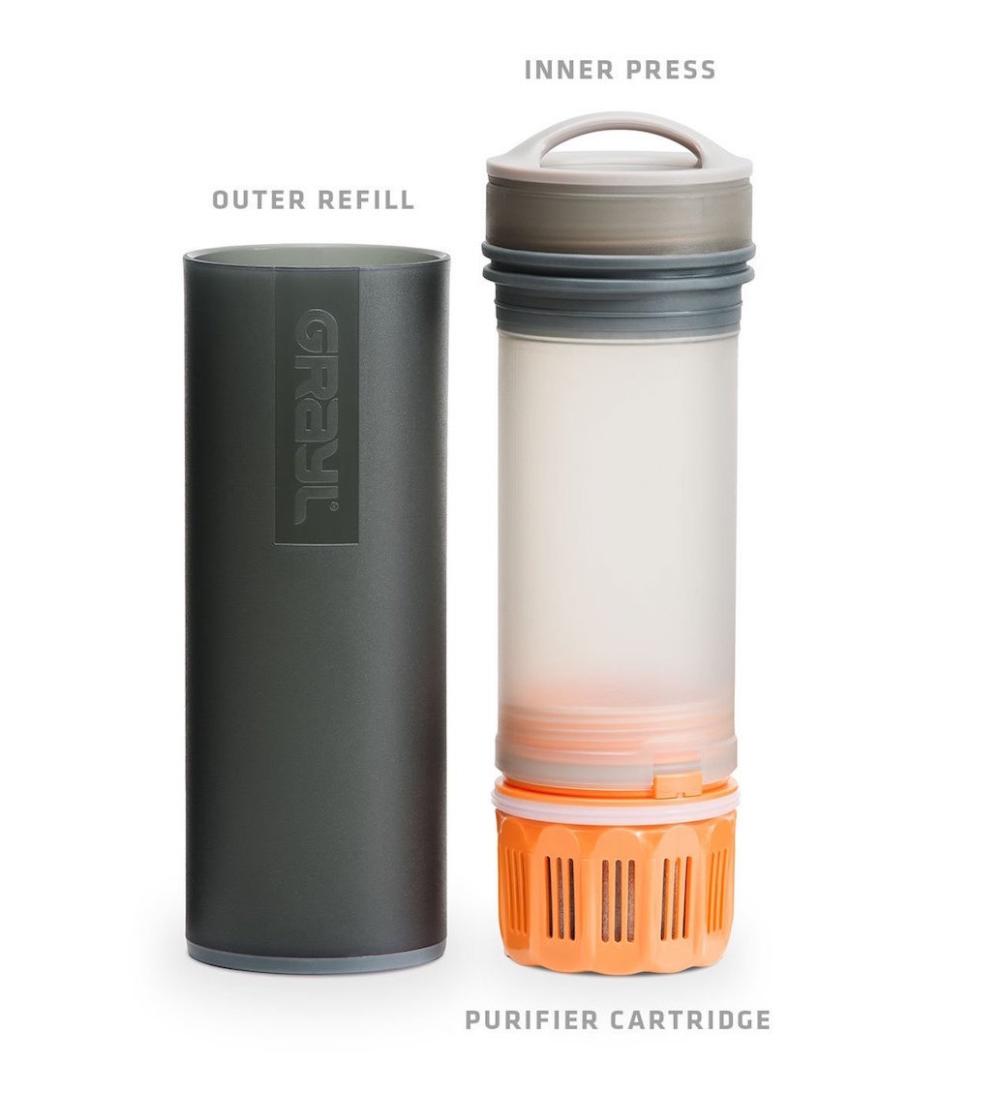
The Grayl Ultralight has a unique design and modus operandi compared to most other water purifiers in that it works very much like a French press coffee filter.
The unit is available in four colours – black, blue, green and orange.
The first thing you should know about the Grayl Ultralight is that it’s not really “ultralight” in absolute terms but only in relative terms - the original Grayl made of stainless steel weighed almost twice as much.
At 10.9 oz (309 g), the Grayl Ultralight is still significantly heavier than most of the other water purifiers on our list, which could be a deal-breaker for the ultralight traveller right off the bat.
In terms of size the unit is comparable to a typical water bottle and will fit neatly inside your average backpack side mesh pocket.
The Grayl Ultralight consists of four components in total – an outer vessel, an inner vessel, a replaceable filter cartridge and a screw-top cap.
The two vessels are made of polypropylene #5 (a BPA-free plastic) and fit seamlessly together; the inner, semi-transparent vessel fits very snugly inside the outer, opaque refill vessel.
The inner vessel is where the purified water collects during operation and the replaceable filter cartridge made of ABS (acrylonitrile butadiene styrene) screws onto the bottom of it.
The inner vessel also has a removable ABS screw-top cap with an attachment loop that a carabiner can be threaded onto, allowing you to easily clip the Grayl Ultralight onto your backpack.
The basic idea is that you fill the outer vessel with the contaminated water and then plunge the inner vessel downwards through the water like a French press, which forces water through the filter and into the inner vessel, whence it is then safe to drink.
The semi-transparent design of the inner vessel means that you can see the purified water that you’ve collected inside the reservoir.
The capacity of the inner vessel (where you drink the water from) is about 16 oz or 473 ml, which is definitely on the low end for a water bottle purifier and it means that you’ll have to always count on the next water refill point being reasonably close by.
The company suggests carrying an extra water bladder or a collapsible water bottle if the low capacity is going to be a problem for you.
The overall impression of the Grayl Ultralight is that it’s a fairly sturdy and durable water purification system that should easily stand up to the rigours of international travel and outdoor use.
You’ll also have peace of mind knowing that every GRAYL comes with a 10-year warranty covering workmanship and materials.
The filter
.jpg)
By default the Grayl Ultralight comes with the orange purifier cartridge, which removes the full spectrum of water contaminants, but if you’re buying a replacement filter, you also have the option of buying the blue-coloured tap filter cartridge.
The tap filter cartridge removes tastes, odours, chemicals like chlorine and iodine, and heavy metals like arsenic and lead that are often present in everyday tap water.
It is designed for use at home (if your tap water is already potable) between trips to improve the quality of your tap water.
If buying a replacement filter for travel you’ll want the orange purifier cartridge, as it also offers protection against microbiological contaminants like viruses, bacteria and protozoa, which can be a problem in some parts of the world.
Let’s now take a brief look at the technology inside the orange purifier cartridge that is capable of transforming hazardous, contaminated water into safe, potable water.
The filter cartridge uses a patented G3+TM Filtration Media, combining three different technologies to ensure that only safe, contaminant-free, crystal clear drinking water passes through.
The three combined technologies are:
Electro-adsorption – The Grayl uses relatively large pores overlaid with a positively charged mesh of ions (little magnets) that negatively charged pathogens and inorganic contaminants bind to, while water can still pass through freely. This technology allows for a faster flow rate than filters that rely exclusively on mechanical means of filtration using miniscule pores.
Ultra-powdered activated carbon – This is activated carbon made from coconut shells with a higher surface area (ultra-powdered) than that found in most block or granulated carbon filters. It helps to remove odours, bad tastes and adsorbs a wide range of impurities including chemicals and heavy metals.
Silver treated zeolites – These are anti-microbial agents that suppress the growth of moulds, mildew and bacteria and keep the purifier fresh between uses.
By combining these three technologies the Grayl Ultralight orange purifier cartridge promises full spectrum purification and filtration and all Grayl filters have been tested to NSF/ANSI standards 42 and 53.
The filter removes 99.9999% of viruses such as Hepatitis A and Norovirus, 99.9999% of bacteria such as E.coli and Salmonella, and 99.999% of protozoan cysts such as Giardia and Crytosporidium.
It also removes heavy metals like lead and arsenic, chemicals like chlorine and pesticides, and of course, particulates like silt, sediment, debris and sand.
The filter will withstand freezing once or twice, but it’s generally recommended that you replace the filter if it freezes a second time. Hence you should never leave the Grayl Ultralight in the freezer and you ought to keep it close to your body if you’re using it in sub-zero temperatures.
The filter cartridge is good for about 150 litres or 300 uses, but to make it last as long as possible you should avoid water that’s heavy in sediment and be selective about your refill sources.
Once you’ve exceeded 300 uses it’s recommended that you replace the filter, otherwise you potentially risk drinking contaminated water.
But your best indication for when to change the filter is the water flow rate - when the water flow rate has halved (e.g 30 seconds), that’s your queue to replace the filter.
Assuming you filter 2 litres of water every day, the original filter cartridge would last you about 75 days or 2.5 months, which is definitely on the low end for a water filter.
If you’re embarking on a longer trip than that you’ll definitely need to carry a couple of spare cartridges. Each replacement cartridge costs about $25 on Amazon.
Note that if you don’t use the filter at all after the first use, it will last for about 3 years before it has to be replaced. This is because the activated carbon inside the filter absorbs impurities from the air and degrades over time.
However, this effect that can be somewhat minimized by drying out the filter thoroughly and sealing it inside an airtight bag after the first use.
Operation
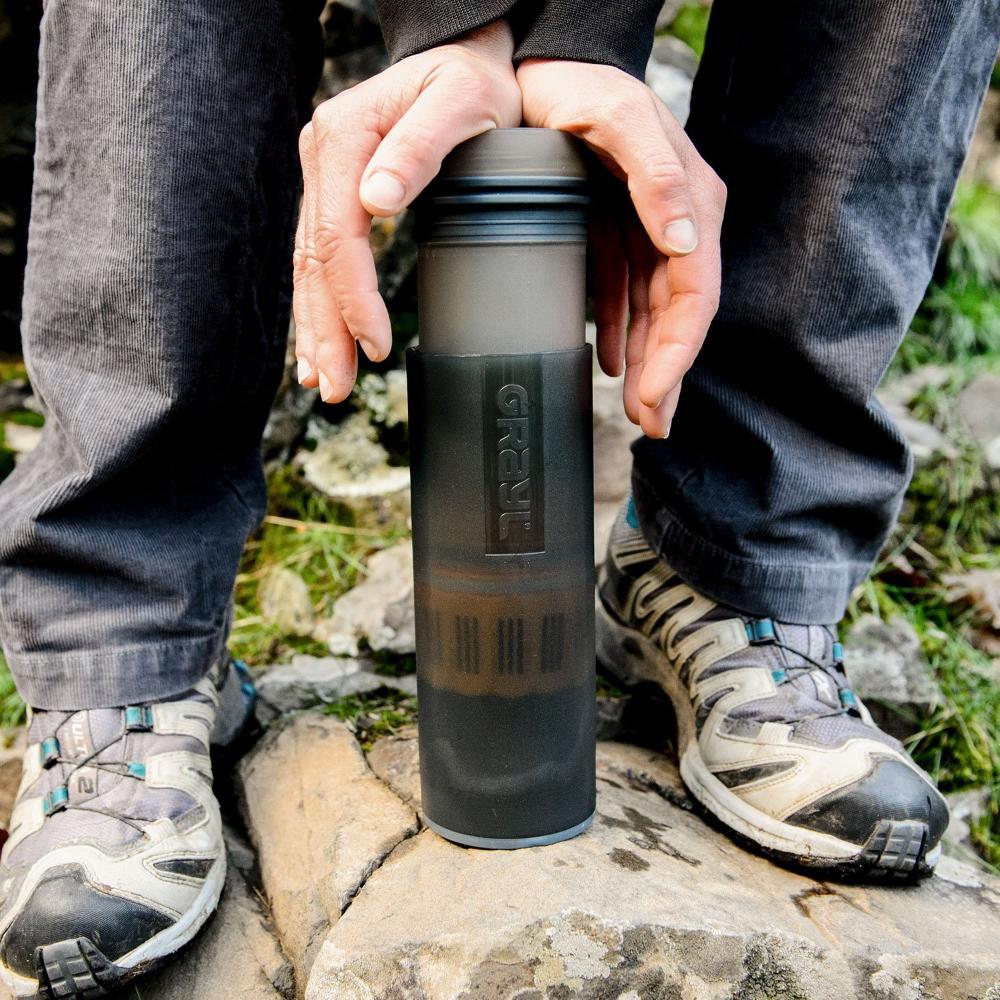
Unlike other water purifiers that push water through a filter via the forces of gravity, squeezing, pumping or sucking, the Grayl Ultralight operates in the reverse manner, by pushing a filter through water.
Operation of the Grayl Ultralight can be summarized by the company’s three-word motto:
Fill. Press. Drink.
First remove the cap and then separate the inner vessel from the outer by pulling and twisting at the same time.
Next, take the outer vessel and fill it with the dubious water that you want to purify. There’s a line marked on the vessel that indicates the maximum fill level.
Make sure that the cap is either fully removed or loosened through a quarter turn before you begin pressing. This is so that air inside the inner reservoir can escape.
Now, place the filled outer vessel on a reasonably flat, stable surface and begin pressing the inner vessel downwards through the water as if operating a French Press.
The best way to do this is to bear down on it from above, using your own bodyweight to give yourself the greatest possible mechanical advantage. Don’t cup the palms of your hands over the top of the inner press, as this could prevent the pressure from releasing.
As the press moves downwards the contaminated water will be forced through the filter cartridge at the bottom and will slowly start to fill the inner vessel.
The whole process only takes about 15-30 seconds and afterwards you can drink the purified water straight out of the inner vessel or you can transfer it to another vessel if you wish.
Some users have reported that this pressing action starts to hurt the hands after repeating it a few times and due to the relatively small capacity of the vessel you’re obviously going to have to do multiple presses during a sweaty hike.
Value for money
In terms of cost per litre, the Grayl is one of the least competitive water purifiers on our list.
It normally sells for around $60 on Amazon and we know that it filters approximately 150 litres, so the first 150 litres will work out at about 40 cents per litre.
This would save you money versus buying bottled water in most developed countries, but bottled water can be cheaper than this in many developing countries.
Replacement orange purifier filters currently cost about $25 on Amazon, so after going through the first filter the cost per litre drops to around 17 cents, which is much more favourable than the initial cost per litre, but still isn’t much cheaper than buying bottled water in some developing countries.
Pros
- Interchangeable filters
- Easy to maintain
- Decent flow rate
- Simple and reliable (no batteries, chemicals, pumps, UV bulbs, hoses etc.)
- All-in-one solution
Cons
- Filter lifespan is very short
- Capacity could be greater
- Heavier than most of its rivals
- Requires physical effort to operate
- No drinking spout (makes it difficult to drink on a shaky bus or while riding a bike)
- Cost per litre isn't very competitive
Is it for you?
The Grayl does have a very cool and unique means of purifying water by working like a French press.
But if you’re looking for a water purifier that will remove the full spectrum of waterborne contaminants, we don’t think this is the best option.
The Grayl is heavier, has less water holding capacity, has a shorter filter lifespan and is less cost-effective than other water purifiers in this list that accomplish the same feat.
Before buying the Grayl we’d advise you to check out three other water purifiers below that can also remove viruses, heavy metals and chemicals; the Water To Go Filter Bottle, Aqua Pure Traveller and the LifeSaver.
#2 - Sawyer Mini Water Filter
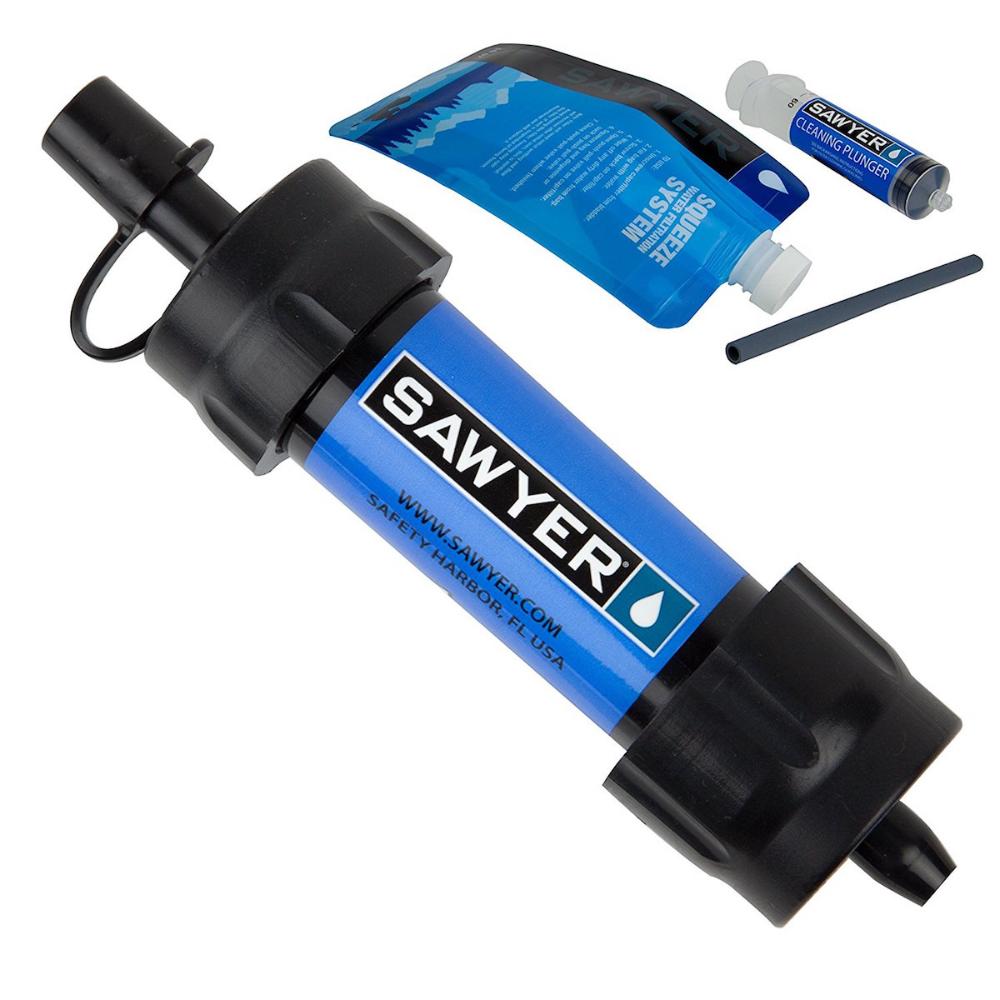
Specs
Dimensions: 8 x 4 x 3 inches
Weight: 1.8 oz (50 g) (when wet)
Capacity: n/a
Colour: Black, blue, camo, green, orange, pink
Flow rate: Variable
Purification method: Mechanical, hollow fibre membrane technology
Pore size: 0.1 microns
Removes: Bacteria, protozoa
Filter lifespan: 100,000 gallons
Cost per litre: Depends
The Sawyer Mini Water Filter is another very popular and ultra-portable water purification system that’s perfect for camping, hiking, hunting, fishing, international travel and emergency preparedness.
The product is manufactured by Sawyer Products Inc., a US based outdoor gear company that is specifically dedicated to ridding the world of two of humanity’s biggest killers; unsafe drinking water and mosquito bites.
Sawyer’s water filtration products are known for their ability to filter contaminated water to a higher standard than US bottled water.
In addition to water filtration systems, the company also sells insect repellents, sunscreens and first aid products, and has offered some of the world’s most technologically advanced products in these fields since 1984. You can learn more on the Sawyer's website about page.
Like many other companies that sell water purifiers, Sawyer has a humanitarian mission to bring safe drinking water to developing countries with contaminated water supplies and they’ve partnered with more than 100 charities, NGOs and other organizations around the world to make this dream a reality. You can learn more about what they do for developing countries on Sawyer International.
All the Sawyer water filters meet or exceed EPA (Environmental Protection Agency) recommended removal rates.
Product description
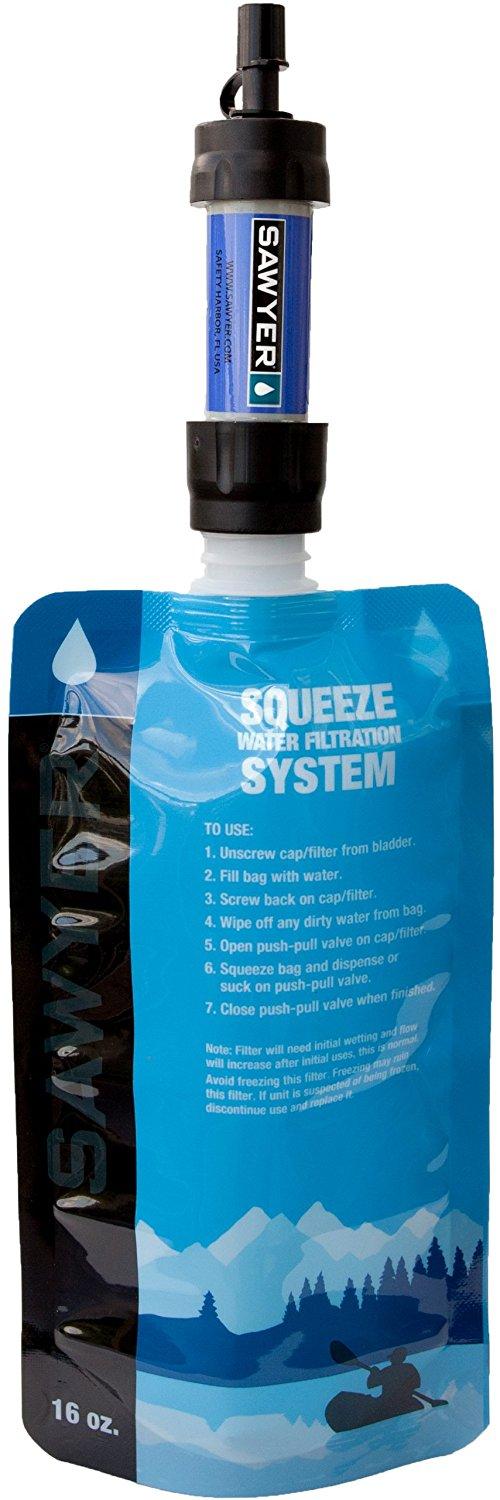
The Sawyer Mini Water Filter definitely lives up to its name and is indeed very lightweight (less than 2 oz) and super compact, fitting comfortably in the palm of a hand.
It’s smaller, skinnier, cheaper and significantly lighter than the original Sawyer Squeeze Water Filter System, which weighs 3.25 oz (92 g) when wet.
One thing it lacks is the faucet attachment that the Sawyer Squeeze has for directly filtering water from taps, but that’s because the Sawyer Mini is primarily designed to be used on the move rather than as a permanent filter on your tap at home.
Because of its compactness The Sawyer Mini is very pocket-friendly, which is just as well, because the filter is of the hollow fibre membrane variety and will be rendered useless if it freezes.
Being able to keep the filter in a pocket close to the warmth of your body will help prevent the filter from freezing if you’re using it in sub-zero temperatures, though the filter is safe in any case if it has never been wetted.
The Sawyer Mini comes in six different colours - black, blue, camo, green, orange and pink.
The unit has a cylindrical shape and there’s an arrow painted on the body that indicates the direction that the water you’re filtering should flow through the filter, making it pretty idiot-proof.
At one end of the filter is a threading that allows you to directly attach the provided squeeze pouch (or any other water bladder) or a standard 28 mm disposable water/soda bottle to the filter.
There’s also a nipple at each end of the unit, allowing you to mount the filter inline with your hydration pack system.
The filter comes in the box with three other accessories - a small 16 oz Mylar squeeze pouch (0.75 oz), a 7” drinking straw attachment (0.22 oz), and a cleaning syringe (1.13 oz) for backflushing the filter.
Many people feel that the 16 oz squeeze pouch that comes with the filter is too small, but if you want something bigger you can order separately a small set of 32 oz or 64 oz pouches for $8-10 here.
If you don’t like the Sawyer pouches at all you can use a water bladder instead with your filter instead. Ultralighters like to use Evernew hydration packs.
Some users have reported that the included squeeze pouch leaks but this normally happens because of misuse – you should roll the pouches up gently instead of folding them aggressively and don’t squeeze the pouch too hard when filtering water.
Still, it might be no harm to pick up a few spare pouches in case you do spring a leak at an inopportune moment.
The Sawyer Mini comes with a limited lifetime warranty against any manufacturing defects. Sawyer is a reputable company that will replace your filter if it doesn’t work as it should. However, if you let the filter freeze you will have voided the warranty.
The filter
.jpg)
Okay let’s look now in more detail at the inner workings of the Sawyer Mini filter.
Like the LifeStraw, The Sawyer Mini uses hollow fibre membrane technology, which was developed from advanced kidney dialysis filtration technology.
The filter is comprised of a great number of tiny U-shaped hollow fibre micro-tubes that allow water to enter the tubes via tiny pores in the sides of the tubes.
This technology allows the water to pass through the filter freely at a high flow rate while trapping sand, silt, dirt, debris and many harmful microbiological contaminants. The water that emerges will be crystal clear, no matter how opaque or muddy the original source.
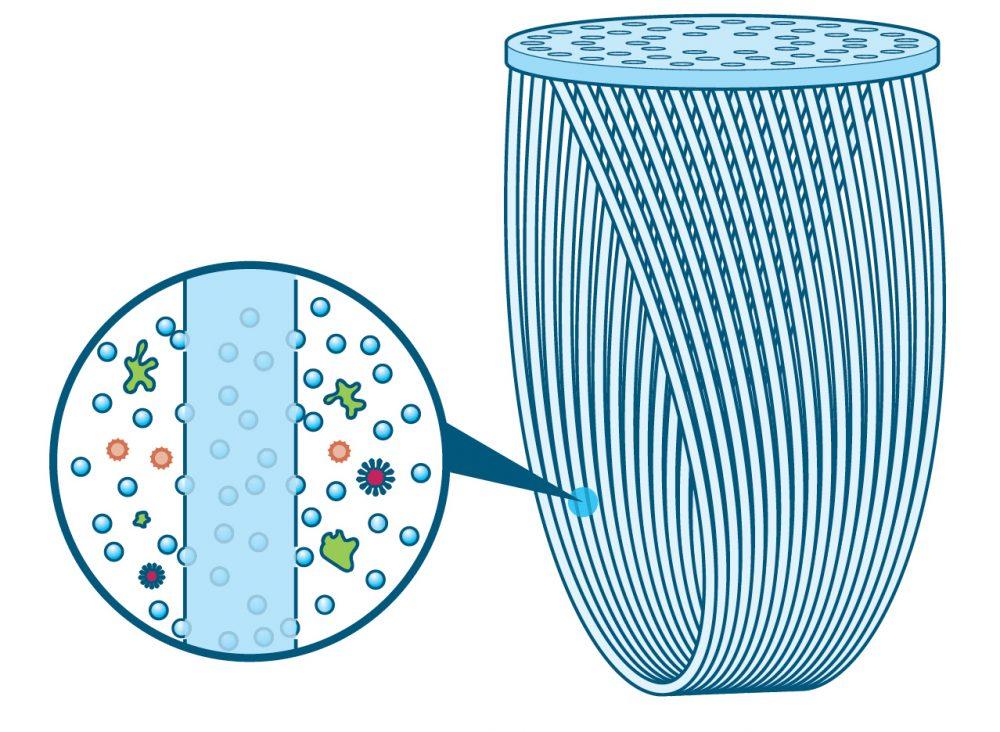
The filter provides 0.1 micron absolute filtration (meaning that no pore is larger than 0.1 microns), removing 7 log (99.99999%) of all bacteria, including E. coli, cholera and salmonella, and 6 log (99. 9999%) of all protozoa, including Giardia lamblia and cryptosporidium.
The company claims that the filter was tested to 10 million parts of bacteria and one million parts of protozoa without a single breakthrough.
All the Sawyer filters are air tested 3 times before leaving the production facility, to ensure that no pathogens can slip through the filter fibres. This is a claim that apparently no other company can make.
If you’re still unconvinced check out the Sawyer Mini testing report. (we’ve pulled the link from the downloads page on the company’s website).
The Sawyer Mini will not remove viruses, chemicals, heavy metals, tastes or odours, as it is primarily designed for usage in wilderness areas and in international cities where water sources are usually free of such contaminants and problems.
If you are visiting developing countries (especially rural areas) where water sources could potentially be contaminated with viruses, you will need to use water purification tablets, UV treatment or boiling in conjunction with this filter.
If you want a water purifier that can also remove chemicals and heavy metals, the Sawyer Mini is not the right product for you because it simply won’t do that.
The flow rate of the Sawyer Mini filter depends on the filtering mode (gravity vs squeeze), how clean the filter is, and on altitude, with the flow rate diminishing the higher you go, but in squeeze mode, you can probably expect a flow rate of around 0.5L per minute.
If you’re looking for something with a higher flow rate check out the Sawyer Squeeze instead, but do note that it’s much bigger, heavier and more costly than the Sawyer Mini.
The Sawyer filters have a far superior lifespan to all the other filters we’ve reviewed in this article and are supposedly good for about 100,000 gallons or 378,541 litres.
If you drank two litres a day from the filter, the filter would last you over 500 years, so as long as you look after it and manage not to break or lose it, it’s basically good for a lifetime. There is no need to worry about replacing filters as is the case with most other purifiers.
The filter rolls up into the included collapsible Mylar pouch so that it occupies minimal space in your backpack.
Operation
.png)
The Sawyer Mini is extremely versatile and can be used in a multitude of different ways.
1) You can attach the filter to a Sawyer Squeeze Pouch or water bladder via the screw threading, and either drink directly from the filter spout or dispense the purified water into another vessel.
Squeezing the bladder or squeeze pouch will increase the flow rate but don’t squeeze too hard lest you spring a leak at the weak point near the threading. This can and has happened to overzealous users.
2) Standard disposable 28 mm threaded water/soda bottles will also screw onto the filter and can be used in the same manner as the pouch or a water bladder.
This capability is great for when you don’t trust a dubious brand of bottled water overseas or when you’re only carrying a standard disposable plastic water bottle with you on your trek.
Other similar filters (such as the LifeStraw) won’t allow you to drink water from standard disposable bottles and will only work with a wide mouth bottle.
3) You can also fit the straw attachment onto the filter and drink directly from any water source such as a lake, pond, puddle or from a wide-mouth water bottle.
4) You can use the filter inline on a hydration pack without any additional adapters required. Just fill your hydration pack from the water source and filter water as you’re drinking through the bite valve.
We will add that these last two methods do require you to suck pretty vigorously, and for that reason most people prefer to use the first two methods.
For 1), if you’re dispensing the water into a collecting vessel, instead of actively squeezing you can suspend the Sawyer squeeze pouch from something (it has a perforated hole to attach cordage to) and allow gravity to do the work instead. Although this passive filtering method is slower, the advantage is that it allows you to multitask.
Cleaning the Sawyer Mini requires the use of the cleaning plunger that comes with the kit to backflush the filter.
It’s recommended that you backflush the filter at the end of each outing before putting it away into storage, or whenever the flow rate begins to diminish. You should also backflush the filter after taking it out of storage to re-wet the filter and restore a good flow rate.
The first step is to fill up the cleaning plunger by drawing filtered water into it with the plunger.
Next, attach the nipple of the plunger to the nipple on the end of the filter that the flow arrow is pointing to. Finally, forcefully push the water back through the filter using the plunger.
If that all sounds like a lot of work, most ultralight travellers and backpackers consider it a better alternative than having to carry around replacement filter cartridges.
Also, if you have a Smartwater water bottle you can leave the syringe at home and save weight, because the flip-top of this bottle mates perfectly with the nipple of the Sawyer Mini, allowing you to backflush the filter directly from the water bottle instead of using the plunger.
Check out this Youtube video for a tutorial on how this is done.
Value for money
At first glance the Sawyer Mini Water Filter offers outstanding value for money, providing 100,000 gallons of bacteria and protozoa free water at a price of approximately $20 on Amazon.
Now in theory that works out at around 0.005 cents per litre, but in practice you’re probably not going to live long enough to filter 100,000 gallons of water.
But lets say you get an optimistic 10 years of use out of the filter until it breaks, freezes, you lose it, the filter membranes start to degrade etc.
In that case, assuming you filter 2 litres per day, you would get about 7,300 litres of clean water from the filter, giving a cost per litre of 0.27 cents, which is still excellent value for money.
Bear in mind though that the Sawyer Mini does not remove viruses, chemicals or heavy metals so we should expect the cost per litre to be lower than for filters that do remove those contaminants.
You’re also probably going to go through a few squeeze pouches or water bladders over time and will have to pay to replace those. That said, the Sawyer Mini is a very versatile piece of kit and you may be able to get by without them.
Pros
- Ultra-portable (lightweight & compact)
- Highly versatile (pouch, disposable bottle, inline, straw)
- Simple and reliable (no batteries, chemicals, UV bulbs, pumps etc.)
- Incredible value for money (potentially provides a lifetime of clean drinking water)
Cons
- Freezing may render the filter useless
- Not an all-in-one solution
- Not universally dependable (won't remove viruses, chemicals or heavy metals)
- Requires frequent backflushing
Is it for you?
If your travels generally remain confined to international cities or relatively pristine backcountry areas, you probably don’t need something that can remove viruses, chemicals and heavy metals.
In that case we think the Sawyer Mini would be an ideal water purifier to choose because of its immense portability and versatility. Additionally, the massive filter lifespan and value for money is really difficult to argue with.
There is another similar ultra-portable water purifier called the Lifestraw (reviewed next) but it lacks the versatility and filter lifespan of the Sawyer Mini.
However, you might want to check out the Lifestraw first in any case, before committing to a final decision.
#3 - LifeStraw Personal Water Filter
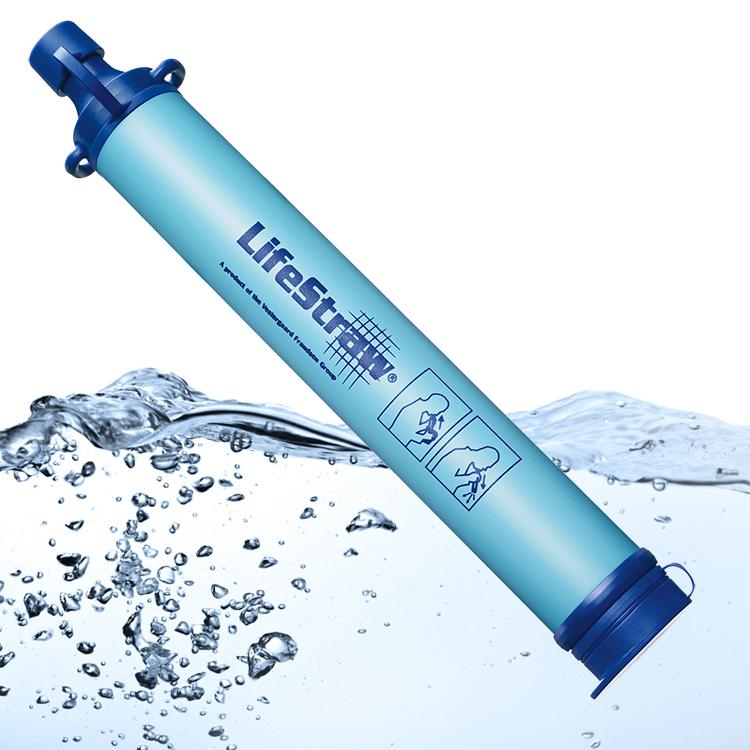
Specs
Dimensions: 9 x 1 x 1 inches (22.5 x 2.5 x 2.5 cm)
Weight: 54 g
Capacity: n/a
Flow rate: 1.7L/min
Purification methods: Mechanical, hollow fibre membrane
Pore size: 0.2 microns
Removes: Bacteria & protozoa
Filter lifespan: 4,000 litres (1000 gallons)
Cost per litre: 0.375 cents
The LifeStraw Personal Water Filter is one of most highly rated, popular and acclaimed water purifiers on the market with an almost cult-like following.
It markets itself as an effective, portable water purification system for travellers and especially outdoor folk, as well as a solution to unsafe drinking water for people living in developing countries.
The product has received a number of accolades, having won Time Magazine’s Invention of the year, Esquire Magazine’s Innovation of the year and the Saatchi & Saatchi award for World Changing Ideas.
The manufacturer of the LifeStraw is a Swiss-based public health company called Vestergaard.
It all began in 1994 when the Carter Center approached Vestergaard to develop a filter that could remove Guinea worm larvae from water it was contaminating.
Vestergaard first came up with a cloth filter but by 1999 had developed this early prototype into a tubular filter, a more primitive version of today’s LifeStraw.
This Guinea worm filter developed by Vestergaard was very successful and almost eradicated the disease.
Its impact inspired the company to develop an even better filter that would remove virtually all the harmful microbiological contaminants found in water.
These efforts finally resulted in the appearance of the LifeStraw in 2005. The product was originally designed for people in developing countries who didn’t have access to safe drinking water, as well as for people surrounded by contaminated water following natural disasters.
.jpg)
In fact, over 4,000,000 LifeStraws have been distributed for humanitarian aid since 2005, as part of relief efforts for major natural disasters like the Haiti earthquake, Pakistan floods, and Typhoon Haiyan in the Phillipines.
By buying a Lifestraw you’re also supporting a child in a developing country with the company’s Follow The Liters Program.
The idea with this program is that for every LifeStraw sold in North America the company supplies a child in a developing country with safe drinking water for an entire school year.
Product description
.jpg)
The LifeStraw is a very simple one-piece water purifier made from BPA-free plastic, which extends to about 9 inches in length and has a fairly sleek (1 inch thick) tubular profile.
There’s a drinking spout at one end and a mesh filter opening at the other. The two ends are each protected by a plastic hinged cap, so that you don't lose the caps.
The LifeStraw functions very much like an ordinary drinking straw, only that it also filters and purifies the water that you suck up through it, removing most hazardous microbes, tastes and odours from the water before it reaches your lips.
The unit also comes with an attachable Lanyard for hanging it around your neck so that you can carry it hands-free.
There are two very important things to note about the LifeStraw.
The first is that it's very much designed to be a personal water purifier.
You can only drink directly from the straw by sucking up water and can't dispense the decontaminated water into a collecting vessel, as is possible with most other water purifiers.
This means that it's not ideal for sharing among two or more people (unless they don't mind sharing germs) and it can't be used to dispense purified water to members of a group. It's mainly designed for you and you only.
The second important thing to note about the LifeStraw is that it's more suited for use in the backcountry than for general travel.
The design as a drinking straw makes it easy to suck up water from difficult-to-reach places found in the wilderness like rock kettles (water-filled holes in solid rock), tight crevices, gypsy wells (water-filled holes dug next to a river) and so on.
It's also useful for water sources like puddles where the water is too shallow to effectively fill a hydration bladder or a water bottle with. In this kind of scenario you can just suck up the water directly from the puddle into your mouth with the LifeStraw.
The LifeStraw is still very useful for travel and many people do travel with their LifeStraw but we just wanted to make the point that it's especially advantageous for use in the backcountry.
Let's now take a closer look at how the LifeStraw purifies water and see what exactly it can remove.
The filter
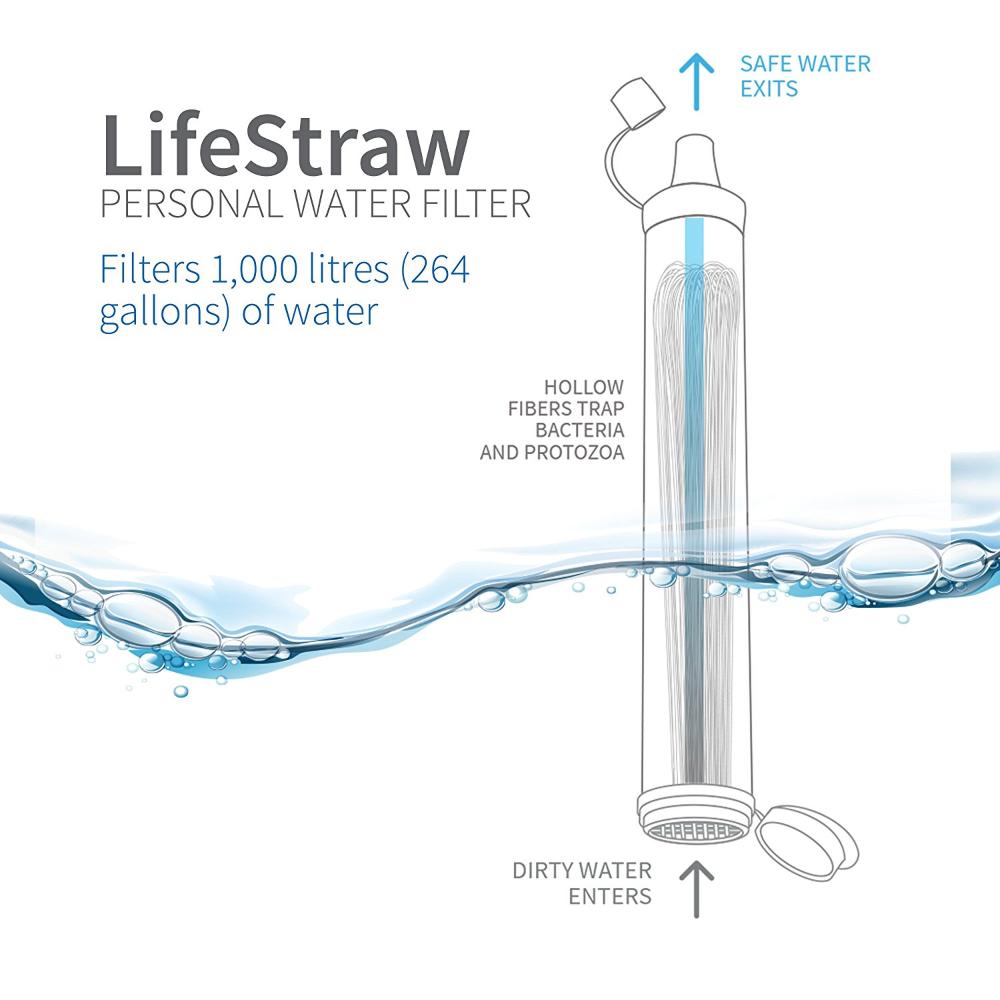
Inside the LifeStraw casing is where the magic happens so to speak.
The filtration process used in the LifeSaver is entirely mechanical and there are no chemicals, moving parts or batteries required for its operation.
The water first passes through two polyester textile pre-filters with mesh sizes of 100 and 15 microns, in order to remove any particulates, sediment or debris and ensure crystal clear drinking water, no matter how muddy or turbid the original water source.
Like the Sawyer Mini, the LifeStraw filter also utilizes advanced hollow fibre membrane technology, employing hollow fibres that mechanically trap bacteria and protozoa while allowing water to pass through.
The LifeStraw filters to 0.2 microns, and will remove 99.9999% of bacteria including E-coli, campylobacter, vibrio cholera, pseudomonas aeruginosa, shigella, salmonella etc. and 99.9% of protozoa including giardia lamblia (beaver fever), cryptosporidium parvum and entamoeba histolytica.
Check out this report found on the company's website to see all the different nasties that the various LifeStraw products filter out of the water.
The LifeStraw does not remove viruses, chemicals or heavy metals, so it’s not universally dependable.
However it's fine for when you’re camping, fishing or hiking out in the backcountry, and should also be safe to use in most international cities, since these contaminants are very rare in such scenarios.
But you shouldn’t trust the LifeStraw with your life in say, rural areas in developing countries, where viruses like Hepatitis A and rotavirus, heavy metals like mercury, cadmium and lead, and chemical contaminants like PCBs, pesticides, aromatic hydrocarbons etc. can often be present in water sources.
If the problem is chemicals or heavy metals as opposed to viruses, perhaps due to agricultural or industrial run-off, you might be better off with the LifeStraw Steel.
The LifeStraw Steel is a slightly larger (9 x 1 x 1 in), significantly more expensive (x 4), heavier (118 g), stainless steel version of the LifeStraw that comes with a 2-stage filter instead a standard 1-stage filter.
It has a replaceable activated carbon capsule in the bottom of the unit that helps to reduce levels of chlorine, organic compounds and heavy metals, as well as unpleasant tastes and odours.
The carbon filter has some limitations when it comes to removing heavy metals and certain chemical contaminants (it won’t remove lead for example) but it’s definitely a step up from the LifeStraw.
But let’s get back on track here and continue our discourse on the standard LifeStraw.
The filter has a respectable flow rate of about 1.7 L per minute, which is on the high end for a water purifier, so you'll be able to quench your thirst quickly when sucking water through the unit.
The LifeStraw filter will provide up to 4,000 litres (1000 gallons) of safe drinking water before it expires. If you were to drink 2 litres of water per day with the filter, it’d last you about 5.5 years.
Cleaning the LifeStraw regularly (method described below) will help to prolong the life of the filter.
You'll know the filter has had its day when the flow rate decreases and then water stops flowing through the filter altogether. You won't end up drinking contaminated water when the filter expires.
There is no way to replace the spent internal mechanism once spent; you just have to buy a brand new LifeStraw. So if you’re planning an extended multiyear trip you might want to buy more than one.
Because the LifeStraw filter uses hollow fibre membranes like the Sawyer Mini, it is also susceptible to freezing temperatures and you should try to keep it close to your body if you're using it in such conditions. If you suspect it has been frozen you should replace it immediately.
Operation
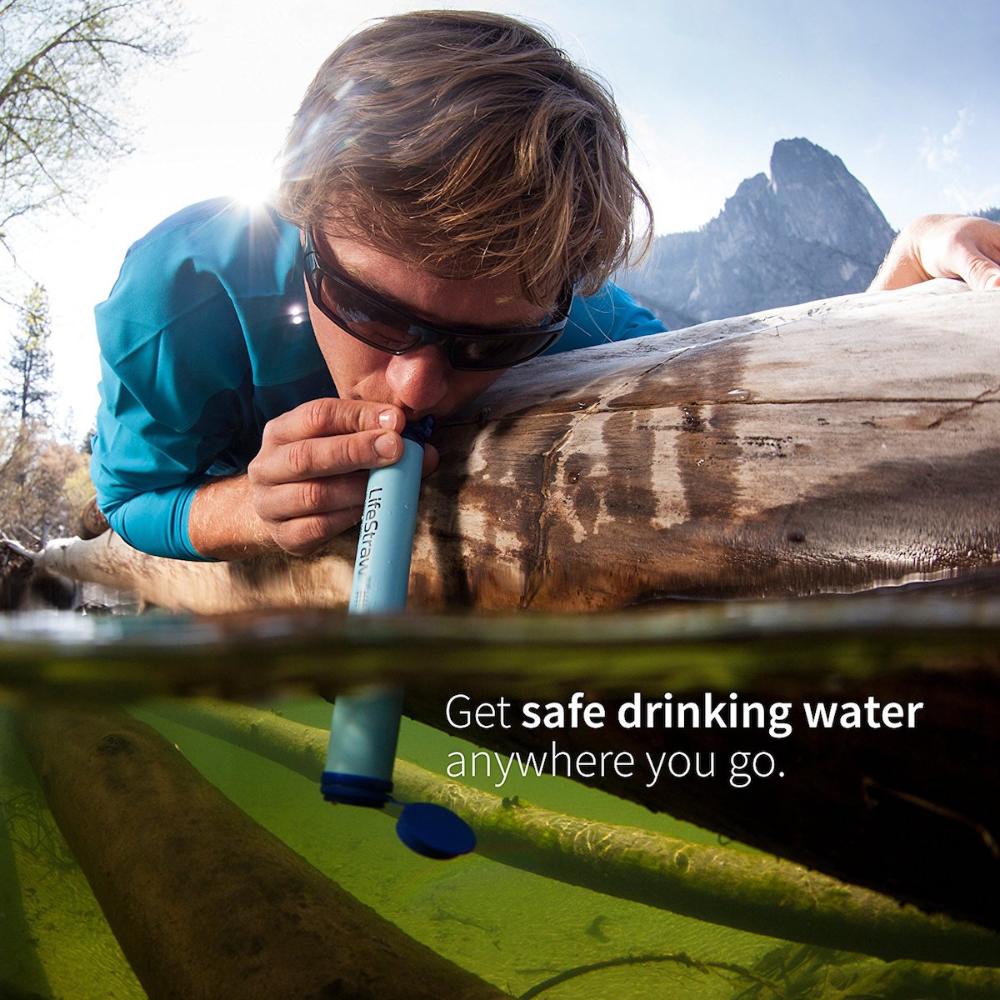
Operation of the Lifestraw is very simple and straightforward and requires no complicated pumping mechanisms, squeezing or any physical effort.
First remove the top and bottom caps and then immerse the end of the Lifestraw into the water source that you wish to drink from, whether that’s a river, pond, lake, puddle, rock crevice, wide-mouth water bottle, water-filled sink etc.
One drawback here is that the LifeStraw won’t allow you to drink from standard disposable water bottles or water bladders, as the opening in these vessels is too small for the straw to fit inside.
Drinking from a tap when travelling could also be a problem; you’ll need to first fill a canteen, wide-mouth water bottle, sink, bucket or other vessel with a sufficiently wide opening and then drink from that using the LifeStraw.
In any case, once you’ve immersed the straw in the water, wait for a few moments for the water to fully wet the membranes, and then simply suck up the water as you would with a normal straw.
The device is designed for you to drink directly from it rather than first dispensing the purified water out into another vessel and then drinking from that.
When you’ve quenched your thirst, you should backflush the membranes by blowing the dirty water that's trapped inside the filter back out the opposite end. This action helps clean the filter.
If you have access to clean water, you should also suck some of this water up into the filter and then backflush it again.
If you’ll be using the device throughout the day you can replace the caps after each use, but once you’re done for the day you should leave the caps off to let the filter dry out.
.jpg)
Value for money
The cost per litre for the LifeStraw works out at about 0.375 cents, which is excellent, but we also have to take into account that the unit doesn’t remove viruses, chemicals or heavy metals.
The value we’re getting is therefore also less than that provided by the water purifiers on our list that do remove these contaminants. Nevertheless, the LifeStraw still offers great value in our opinion.
Pros
- Ultra-portable (compact & lightweight)
- Water can be sucked up from difficult-to-reach places
- Simple and reliable (no pumps, batteries, chemicals, UV bulbs, moving parts)
- Good flow rate
- Decent lifespan
- Good value for money
Cons
- Not ideal for sharing or serving a group
- Not universally dependable (won't remove viruses, chemicals, heavy metals)
- Won't work with a disposable water bottle or water bladder
- Filter is susceptible to freezing
- Requires frequent backflushing
- Not an all-in-one solution
Is it for you?
Like the Sawyer Mini, the LifeStraw markets itself as an ultra-portable water purifier that removes all biological contaminants except for viruses, but won’t filter out chemicals and heavy metals.
The problem with the LifeStraw is that you can only use it like a straw, which is okay for personal use but means you can’t dispense purified water into another container if you want to drink normally for a change, irrigate wounds, wash fruit & vegetables or serve the needs of a group.
The LifeStraw filter also has a shorter lifespan than that of the Sawyer Mini, so you’re not getting quite the same value for money.
For general travel purposes we think the Sawyer Mini is the better choice between the two, mainly because of its greater versatility and greater lifespan.
P.s - The company has come up with a solution to the problem of only being able to use the LifeStraw like a drinking straw with their LifeStraw Go system.
This incorporates a modified version of the LifeStraw filter into a durable, BPA-free, leak-proof water bottle made of Tritan.
The LifeStraw Go can be bought with either the 1-stage standard LifeStraw filter or the 2-stage filter, like that used by the LifeStraw Steel.
The water bottle comes with an attached loop of webbing, and carabiner so that you can easily hang the bottle from a belt or backpack.
LifeStraw Go works very simply; the LifeStraw filter unit first attaches to the underside of the screw-top bottle cap.
You then remove the cap, fill the bottle with water, screw the cap back on with the attached filter and start drinking as you would from a normal water bottle with the food-grade silicone mouthpiece.
The whole system together (filter + water bottle) weighs about 221 g (7.8 oz), while the water bottle alone weighs 168 g (5.9 ounces).
4. Lifesaver 4000 UF Water Bottle
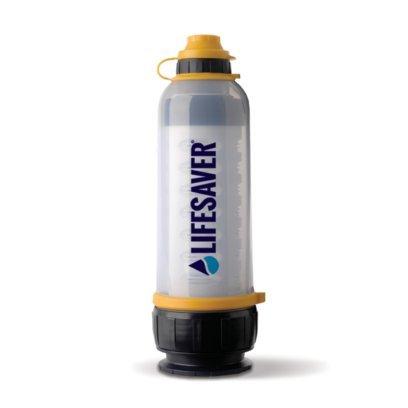
Specs
Dimensions: 12.9 x 4.6 x 4.5 inches
Weight: 635 grams (22 oz)
Capacity: 750 ml (25.3 US oz)
Flow rate: 2L/min @ 0.25 bar (g)
Purification method (s): Ultra filtration (UF), activated carbon block
Pore size: 0.015 microns
Removes: Viruses, bacteria, protozoa, chemicals, heavy metals, particulates
Filter lifespan: 4,000 litres (1,056 US gallons)
Cost per litre: 4.93 cents
The Lifesaver Systems 4000 Ultra Filtration Water Bottle, manufactured in the UK by British company Lifesaver systems Ltd, is another well-known water purification system among travellers, adventurers and outdoor folk.
It works perfectly in virtually any scenario where one has to drink from untrusted water sources, whether you’re in a city, rural area or out in the backcountry.
The product was originally developed to save lives in the wake of natural disasters like Hurricane Katrina and the 2004 Tsunami, and in response to the world’s increasingly threatened supply of safe, potable drinking water.
It was invented by Michael Pritchard, a water treatment expert living in Ipswich, England. He became angry when he saw how there was water to be found literally everywhere in the aftermath of natural disasters, but none of it was safe to drink.
“Water, water, everywhere, Nor any drop to drink”. - Samuel Taylor Coleridge
He lamented how rescue services were trucking in gallons of water for the victims and thought there must surely be a better, more economical solution to the problem than this.
After many failed prototypes, Michael eventually came up with the LifeSaver water bottle in 2007. It was the world’s first portable water filter that could remove the smallest known waterborne viruses.
Due to its efficiency and cost-effectiveness, the British army adopted the LifeSaver in 2010 as their chosen water purification system for personnel operating deeper in the field away from regular camp water supplies.
Since its inception the LifeSaver has attracted an expanding and varied audience in the retail sector, appealing to hikers, campers, outdoorsmen, travellers, backpackers and explorers alike.
The product won the “Best Technological Development for Future Soldier System Enhancement” at Soldier Technology 2007 and is trusted by the armed forces to deliver safe drinking water anywhere in the world.
It has also passed rigorous testing and been approved by the United States EPA (Environmental Protection Agency), the UK Water Compliance Guidelines and the European Drinking Water Directive Council.
Product description
.jpeg)
The Lifesaver is a BPA and BPS (Bisphenol S) free water bottle-cum-purifier with an integrated long-term use replaceable filter and removable carry strap.
Included in the box is a carry strap, a user manual, an instruction sticker, a spare activated carbon filter, a spare rubberized anti-bite nipple, a tub of lithium grease (for greasing the gaskets and internal moving parts) and an LED flashlight.
At over a foot in length, this is definitely quite a large contraption, but as an all-in-one solution with a water bottle and purifier all wrapped up in one neat package, at least you won’t need to carry anything else.
The LifeSaver weighs 650 grams (22 oz), making it the heaviest water purifier on our list by far, so this is definitely not a solution for the ultralight traveller.
The capacity of the bottle is 750 ml, which we feel hits the ideal sweet spot for a travel water bottle. It's enough water to last you most longer journeys but not an excessive amount.
The replaceable UF filter cartridge is housed inside a semi-transparent plastic casing and the bottle has a screw-top cap with a chew-proof, replaceable rubberized drinking teat. A watertight, hinged snap-fit lid
protects the teat when not in use.
The unit also has a base piece that screws onto the threading at the base of the outer plastic casing. This piece contains a replaceable pre-filter disc and is fitted with a long plastic tube and a basic pump. At the base of this piece is the twist lock pump handle.
Due to the outer casing being made of plastic, some users have expressed some doubts about how durable the unit would be in outdoor environments and whether it might crack if dropped onto a hard surface.
However, the manufacturer has accounted for this and they supply a protective case for the bottle, or you could even improvise your own cheap solution, by wrapping the bottle in bubble wrap.
The filter
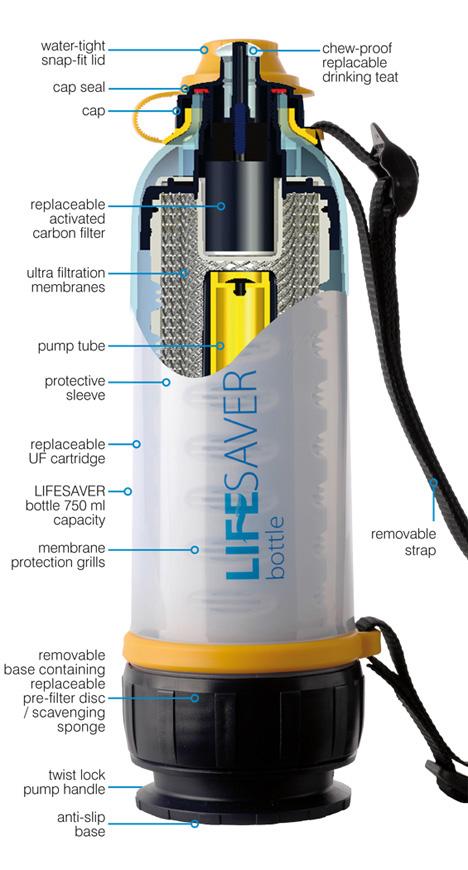
The LifeSaver uses a combination of mechanical filtration and an activated charcoal block to remove particulates, some chemicals and heavy metals, and virtually all microbiological contaminants from the water that passes through its filter.
Firstly, the water passes through the pre-filter disc (made of spongy, absorbent material), which protects the delicate membranes of the filter from large debris like twigs, leaves, sand and dirt, thus prolonging the overall life of the filter.
According to an animated YouTube video produced by the company, the water then passes through a mesh that’s 100 nanometres across, removing most of the particulates and some of the larger microbes.
It then passes through the nano-filter, which consists of UF hollow fibre membranes with miniscule pores that are just 15 nanometres across.
These tiny pores block all the remaining pathogens via mechanical filtration and prevent even the smallest viruses (17- 25 nanometres) from passing through the filter.
The nano-filter claims to be able to remove 99.9999% of bacteria (Log 6), 99.99% of viruses (Log 4) and 99.9% of cysts (Log 3), so it’s pretty damn effective at removing microorganisms.
The LifeSaver is also fitted with an optional and replaceable activated carbon block filter that removes chlorine, tastes and odours, making the water generally more palatable.
This activated carbon filter very simply screws into a receiving thread at the top of the bottle and can filter up to 250 litres of water, depending on the water quality.
The carbon filters are reasonably cheap to replace, costing around $23 for a replacement pack of 4 on Amazon ($5.75 each).
You'll need to keep track of how many litres you've filtered to know when to change the activated carbon filter, as it'll keep passing water after it expires. However if you notice the water has become less palatable this could be an indication that the filter has had its day.
The main filter has an impressive lifespan and will purify about 4,000 litres of water before needing replacement. To put that number into perspective, it would last you 5.5 years if you used it to purify two litres of water every day.
However, once used for the first time the filter will expire after two years, whether you use it or not within that period, so you’ll have to replace the filter cartridge within two years in any case.
If you don't touch the LifeSaver after buying it the product has a guaranteed minimum shelf life of three years from the date of purchase.
As with most other filters, filtering water with a lot of suspended sediment will reduce the lifespan of the filter, so try to use clear water sources whenever possible, or wait for the suspended particles to settle before filling the LifeSaver, and make use of the pre-filter disc.
The LifeSaver filter cartridge has a failsafe mechanism so that by the time it expires the pores will have become blocked with contaminants and the filter will stop passing water.
This means there's no need to guess when the filter needs to be changed and no need to worry about untreated water passing through if you’ve been using the Lifesaver for quite a while.
As you approach the end of the lifespan of the cartridge a greater number of pumps will be required to induce water to flow from the spout until it eventually stops flowing completely.
Note that the cost of replacing an expired LifeSaver filter cartridge is about the same as buying the product brand new again.
The LifeSaver can be used in freezing temperatures but you must ensure that the water inside the bottle doesn't freeze. An insulating wrap or bag can help prevent this from happening. The bottle also shouldn't be left out in direct sunlight or in temperatures exceeding 50°C.
Operation
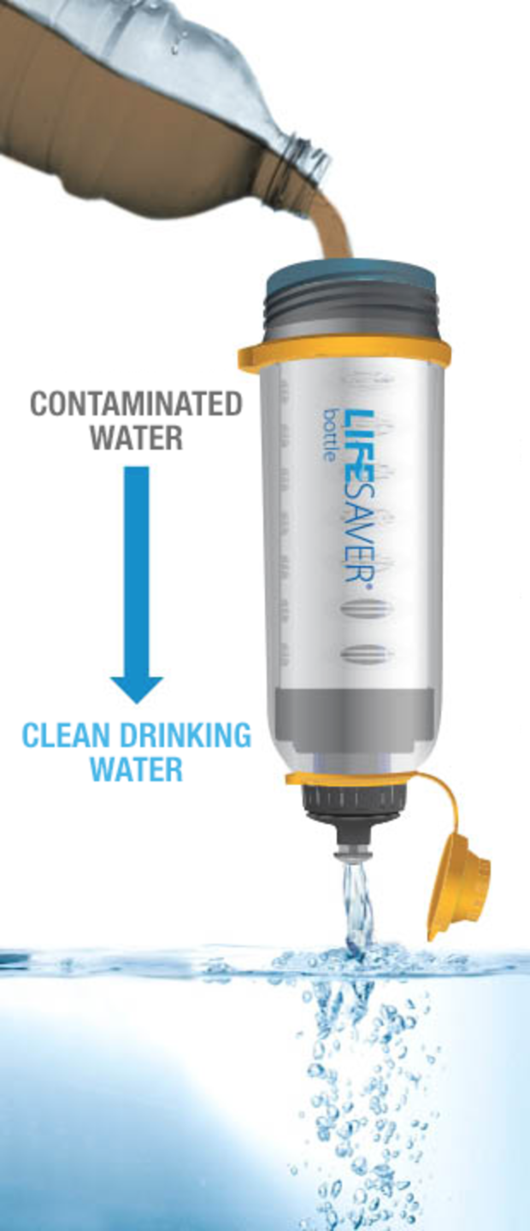
Operation of the Lifesaver is fairly straightforward but before you drink from the bottle for the first time the filter needs to be primed.
Priming must be carried out within 3 years of the date of manufacture.
To prime the filter, unscrew and remove the pump base, flip the bottle upside-down and fill the bottle with water from a tap through the small hole at the base.
Fill the bottle to within 1 inch of the brim, screw the pump base back on and leave to stand for 10 minutes. After 10 minutes, discard the water inside the bottle.
Next, refill the bottle again to within 1 inch of the brim, screw back on the pump base, open the snap-fit lid and nozzle, and operate the pump four times so that water starts slowly flowing from the nozzle.
When the flow slows to a dribble pump another four times. Continue this process until only 1 inch of water remains inside the bottle. Now refill the bottle and repeat the entire process two more times.
The LifeSaver is now primed and ready for normal use.
Note: From this point onwards you should always keep 1 inch of water inside the LifeSaver at all times (except when flying) to prevent the filter membranes from drying out. If putting the LifeSaver away into storage it’s also recommended that you release any pressure inside the unit and remove the activated carbon filter to prevent microbiological growth from occuring (caused by your saliva).
For normal use, operation is similar to priming but there are a few additional things to note.
Holding the bottle upside-down, the first step is to unscrew the removable base piece and set it aside for a moment.
The pre-filter disc should be kept in situ at the base of the unit if you’re filling the bottle with water that’s really turbid or full of floating debris.
The next step is to fill the LifeSaver bottle with the contaminated water that you want to filter via the small hole at the base of the cartridge.
This step will obviously be a cinch if you can hold the bottle under a running tap or hose, but in other scenarios you may need to fill the bottle in a different way.
The pre-filter disc will be your friend in some situations. While you'd normally use it to cover the hole and prevent debris and sediment from entering the filter, the disc can also be usedlike a sponge to mop up water from difficult-to-reach places like small rock crevices or shallow puddles from which it would be impossible to directly fill the bottle.
However a better solution is to carry a proper sponge as a backup, as the pre-filter disc has limited water-holding capacity and it will take you too long to fill the bottle with it.
If you’re filling the bottle from a pond, deep puddle or lake you might think the best method would be to just dunk it in or use a scooping motion to collect the water.
However, due to the fact that the bottle is held upside down while refilling, some of the dirty water will inevitably run down the outside of the bottle and could contaminate the drinking area if you don't have the snap-fit lid tightly closed.
Even if you do keep the lid closed, it's probably still not ideal to have dirty water coming near the mouthpiece area.
What you can do instead in these types of situations is use another small bottle or vessel of some sort and use that to pour the suspect water into your Lifesaver water bottle. You could also squeeze the contaminated water out of a sponge into the bottle, although that would be slower.
In any case, once you’ve filled the bottle with the water that you want to purify, push the pump tube through the pre-filter disc (if it's covering the hole), screw the base piece back in place and now begin operating the pump that is built into the base of the unit.
This pumping action will force air into the bottle, which will in turn force the water through the filter and out through the nipple at the other end, dispensing 750 ml of safe, purified, crystal clear water in under a minute.
You can even pump water out of the bottle when it’s held vertically upright, as water will still be ejected regardless of what angle the bottle is held at.
Note that there's no need to over-pressurize the bottle - just a few pumps is all that's needed to induce the water to flow. In any case the teat of the bottle will automatically open to release pressure if you overdo it.
If the pump feels stiff you might need to apply some of the provided silicone grease to the o-ring at the tip of the pump plunger.
No matter how dirty or cloudy the original water was, the end product will always be totally clear and transparent, a transformation that always amazes a crowd of onlookers.
You can drink the outpouring purified water directly from the teat or transfer it to another vessel if you wish. The stream of sterilized water that spurts from the nipple can also be used to irrigate wounds.
You can adjust the flow rate to your liking by adjusting the degree of openness of the teat.
For more detailed instructions on operation, replacing parts, care and maintenance of the LifeSaver you can also refer to this document.
Value for money
The Lifesaver is fairly pricey to buy outright compared to the other water purifiers on our list, but it does purify 4,000 litres of water, and that includes removal of viruses and some chemicals and heavy metals.
When you do the calculation, the initial cost per litre of the LifeSaver works out at about 2.63 cents.
However that’s only in the absolute best-case scenario, assuming you manage to filter 4,000 litres before the filter expires after two years, which is unlikely to happen unless you’re sharing the LifeSaver with several other people.
We also have to take into account that the activated carbon block filter will need to be replaced every 250 litres or so.
That will therefore need to be changed at least 16 times before you’ve gotten through the 4,000 litres, costing you an additional 2.3 cents per litre.
So in the absolute best-case scenario the LifeSaver is going to cost you about 4.93 cents (2.63 + 2.3) per litre. In reality though, it’s probably going to work out a bit more expensive than that.
Pros
- Excellent filter lifespan
- Fairly low maintenance (no backflushing)
- Removes viruses
- Good value for money
- All-in-one solution
Cons
- Operation could be simpler (involves a pump, moving parts etc.)
- Plastic casing isn't very durable
- Heavy and bulky (not ideal for travel)
- Activated carbon filters need to be replaced quite frequently
- Relatively expensive to buy outright
Is it for you?
If you’re looking for an all-in-one water purification system that removes virtually everything, the LifeSaver will certainly do that, but its excessive weight, bulk and somewhat complicated method of operation will be much of a compromise for most travellers in our opinion.
The LifeSaver filter lifespan is impressive, but then the activated carbon block still needs to be replaced every so often to maintain full performance of the filter.
In our opinion, there are better solutions than the LifeSaver for a personal, portable water purifier that promises to remove the full spectrum of waterborne contaminants.
Have a look at the Aqua Pure Traveller or Water To Go Filter Bottle below to see what we mean.
5. Steripen Adventurer Opti UV Water Purifier
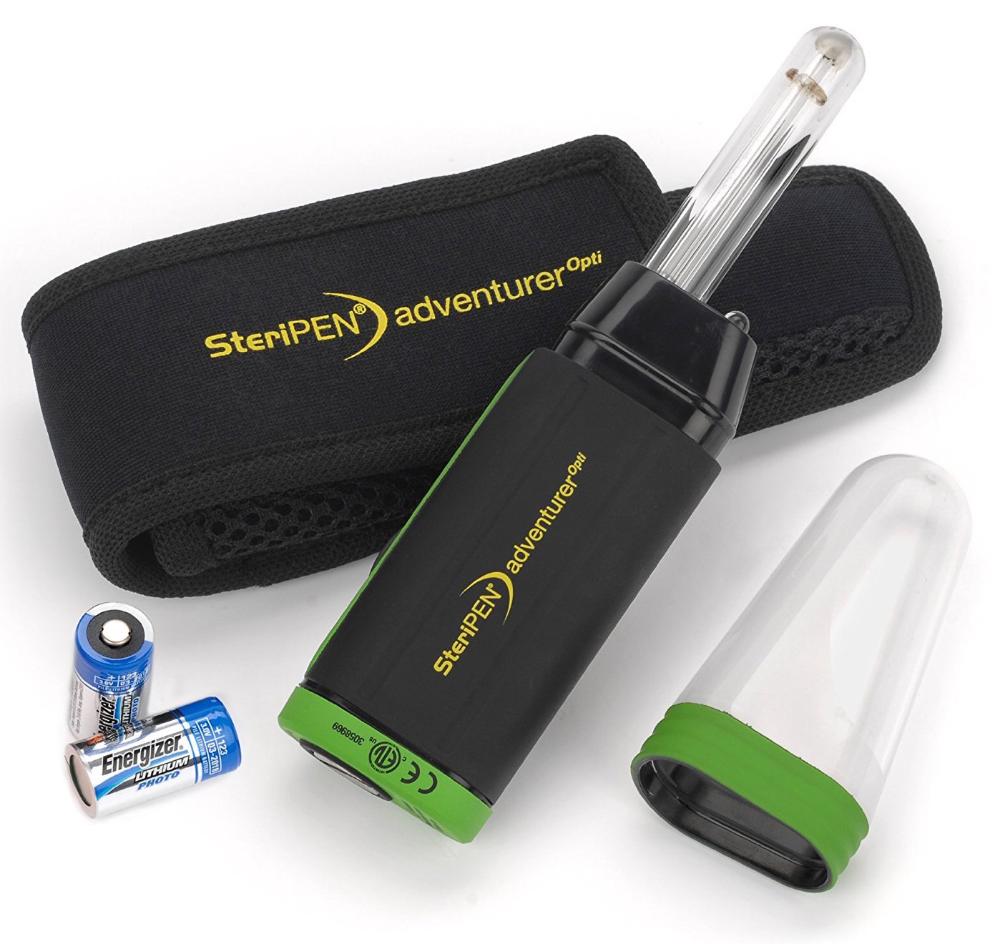
Specs
Dimensions: 6.1 x 1.5 x 1.0 inches (15.5 x 4.0 x 2.4 cm)
Weight: 3.8 ounces (108 g)
Capacity: n/a
Flow rate: 0.666 L/min
Purification method: UV light only
Removes: All microbiological contaminants (viruses, bacteria, protozoa)
Pore size: n/a
Filter lifespan: 8,000 litres
Initial cost per litre: 1.125
Recurring cost per litre: 7.8 cents
The SteriPEN® Adventurer Opti is an ideal water purification system for ultralight travellers, backpackers, hikers, outdoorsmen or adventurers who like to stray off the beaten path.
There is now a whole line of SteriPEN products, all with slightly differing specs, but the Adventurer Opti has been especially designed for adventurous folk that often find themselves in the middle of nowhere without access to the power grid – that’s some of you reading this!
The Adventurer Opti uses a patent-pending optical sensor that only activates when it senses water to ensure safe and effective treatments.
Unlike all the other water purifiers on this list, the SteriPEN devices employ UV technology rather than mechanical, electrostatic or chemical purification methods, harnessing the power of UV radiation to sterilize questionable water.
This is the same technology used by leading bottled water manufacturers, hospitals and municipal water treatment plants in some of the largest cities in the world, including Seattle, New York, Tempe and many others in the North America, Europe and Asia.
The Steripen line was originally manufactured by Hydro-Photon Inc., based in Blue Hill, Maine, where the mountains of Acadia National Park rise to the north and the Camden Hills to the south.
The company was founded by dedicated outdoorsman Miles Maiden, who strongly believed that there had to be a better way to purify water in the backcountry than filters or chemicals.
After several years of research Miles began to focus his efforts on UV technology and how it could be applied to a personal, portable water purification device. The company received its first SteriPEN® patent in 1999.
SteriPEN® was sold to Katadyn North America in 2017, a company based in Minneapolis, Minnesota that develops water treatment systems and products.
In 1999 the first SteriPEN® was sold through REI and in 2011 Time Magazine dubbed the product one of the “Top 100 All-Time Gadgets”
The Adventurer Opti reviewed here was the recipient of Backpacker Magazine’s 2011 Editors’ Choice Award and a 2012 Desnivel award.
SteriPEN is the only portable water purifier that has received the water quality association’s (WQA) gold seal, certifying its safety and efficacy, and that you’re getting exactly what’s advertised.
SteriPEN products exceed the standards set forth in the U.S. EPA Guide Standard and Protocol for Testing Microbiological Water Purifiers.
They’ve undergone a wide range of tests in laboratories and facilities across the U.S and Canada, including the University of Maine, University of Colorado, A & L Laboratory, American Water Works Association, Oregon Health Sciences University, Ryerson University, University of Arizona and University of Southern Maine.
One European study showed that it reduced levels of bacteria and fungal spores in a contaminated water sample by 99.99% and 99.57% respectively, when it was applied correctly.
Product description
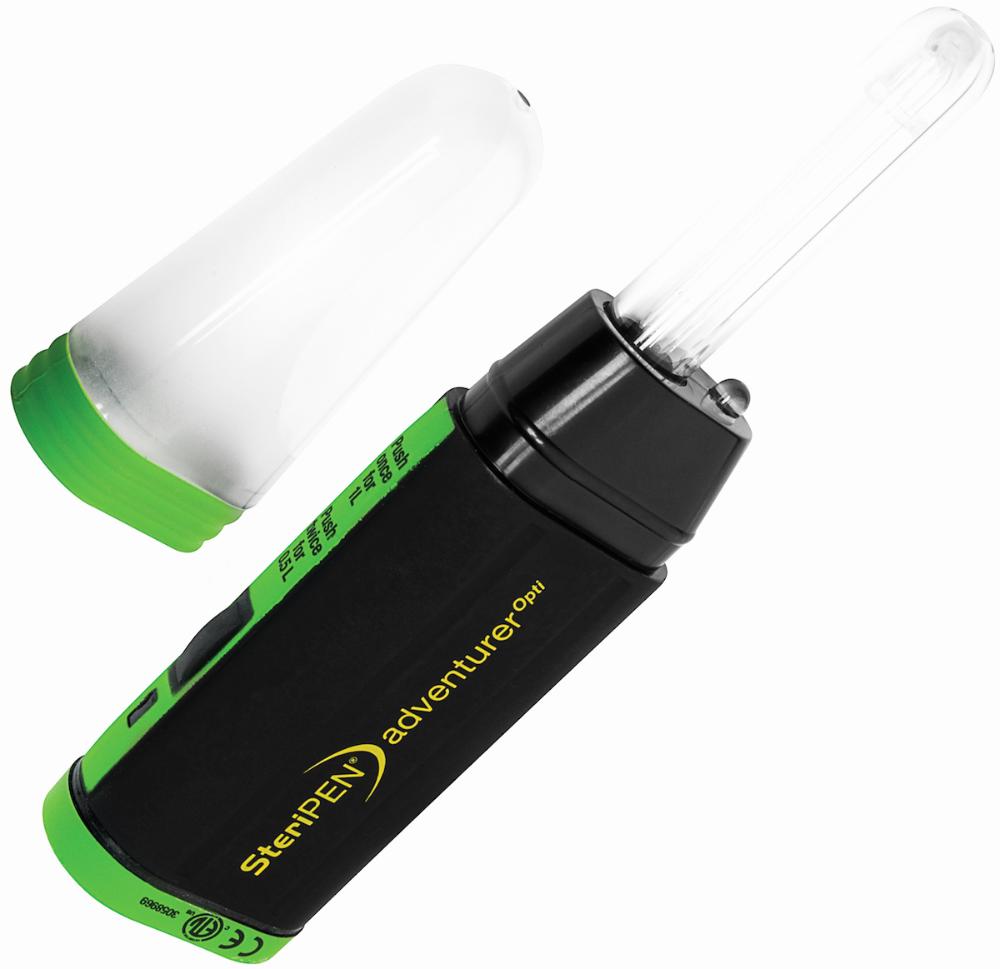
The SteriPEN® Adventurer Opti comes inside a little padded neoprene velcro pouch that has an integrated belt loop.
There’s a button on one side of the device with an LED indicator light right next to it, and some operational instructions are written above the button.
The UV lamp has a removable see-through cap that protects it when not in use while another removable cap at the base covers the battery compartment.
At about 6 inches in length and 1.5 inches in width, this is a very compact little water purification device that’ll fit in the palm of a hand.
Weighing in at 108 g including batteries, it’s not the lightest water purifier on our list, though 3.8 oz. is still fairly reasonable for something that eliminates all pathogens.
However, since the SteriPEN® is not a complete solution, you’ll also need to take into account the weight of the water vessel you’ll be carrying when calculating the overall weight of your water purification system.
The Adventurer Opti can’t be used with bottle mouths that have a diameter of less than 1.75 inches, so you’ll need to carry a wide-mouth water bottle, Gatorade bottle, or something similar.
Despite the fact that the Adventurer Opti has a UV light, the device is still surprisingly sturdy and durable.
The UV lamp is encased in what appears to be glass but what is actually high-strength quartz, affording it greater protection.
Many SteriPENs have not only survived accidental drops off cliffs, but have actually been recovered in perfect working order.
In fact, the company drops each SteriPEN device onto cement from 3 feet during the product development phase to make sure all their products can withstand hard impacts.
They even shot a SteriPEN out of a potato gun across a grassy field and it was still working perfectly after it hit the ground.
SteriPENs are also subjected to electronic testing in house and by third parties like EBW Electronics of Holland, MI. They’re tested beyond their specified lamp life and exposed to temperature extremes.
The unit is powered by two 3-volt CR123A lithium batteries but will also accept RCR123A batteries (rechargeable CR123A batteries).
Each CR123A battery set will purify approximately 50 litres of water before needing to be replaced, while the RCR123A batteries will provide around 30 treatments.
Recommended CR123A battery brands are Energizer CR123 photo lithium battery, Duracell Ultra DL123 (Photo Lithium Battery), Panasonic, Sanyo, Sony, Kodak and SureFire.
You can pick up a pack of twenty Panasonic 3V Lithium CR123 batteries here.
If using RCR123A batteries you should use the highest voltage available – up to 4.2 V per battery works well with the Adventurer Opti.
The company advises against using Alkaline or NiCad batteries with their products.
Now of course, the companies that manufacture water purifiers that use mechanical filters are always boasting about how their units don’t rely on batteries, which they claim could potentially malfunction or run out of juice while you’re out in the backcountry.
It is certainly true that batteries can fail out in the field but it’s not exactly the end of the world if they do.
You should have a backup purification method (like boiling, tablets etc.) in any case, regardless of how reliable you think your water purifier is.
The one major downside we can see with the batteries that the SteriPEN Adventurer Opti uses is that they could be very difficult to find and replace while abroad.
That means that if you were planning a trip lasting several months, you’d be advised to carry a few spare battery sets, which would definitely bump up the weight of the system. Ultralight travellers take note.
The SteriPEN Adventurer Opti has an impressive lifespan and the UV lamp is good for 8,000 litres of water.
If you used it to purify two litres of water per day, it’d last you for almost 11 years, assuming of course that the device doesn’t malfunction before that.
The device is also covered by theSteriPEN Premium Lamplife Pledge, which means that after 8,000 treatments you are entitled to a free replacement, as long as you registered your purchase and originally bought your SteriPEN from an authorized SteriPEN reseller.
Your SteriPEN will actually indicate when it has 100 treatments remaining, and when you get that warning all you have to do is contact SteriPEN support and they’ll tell you how you can get a free replacement.
The SteriPEN Adventurer Opti comes with a 3-year warranty against manufacturing defects, though the return rate due to such issues is only about 1.3%. Water leakage of the UV lamp is one such possible defect in SteriPENS though this only happens once in a blue moon.
As a side note, the battery compartment of SteriPENs is only designed to be splash-proof and is not fully waterproof, so you should never submerge the entire unit underwater.
How it works
The underlying principle behind Steripen devices is that UV-C light rays emitted by the UV lamp are absorbed by the cells of microbes like viruses, bacteria and protozoa, preventing the cell enzymes from “reading” the DNA.
With their DNA deactivated by the UV radiation, the microbes are rendered impotent and unable to replicate in the human body.
The Steripen Adventurer Opti renders harmless 99.9% of all microbiological contaminants in water, including viruses like Hepatitis, bacteria like E.coli, shigella, salmonella, Vibrio cholerae, campylobacter and legionella pneumophila, and protozoa like giardia and cryptosporidium.
Operation
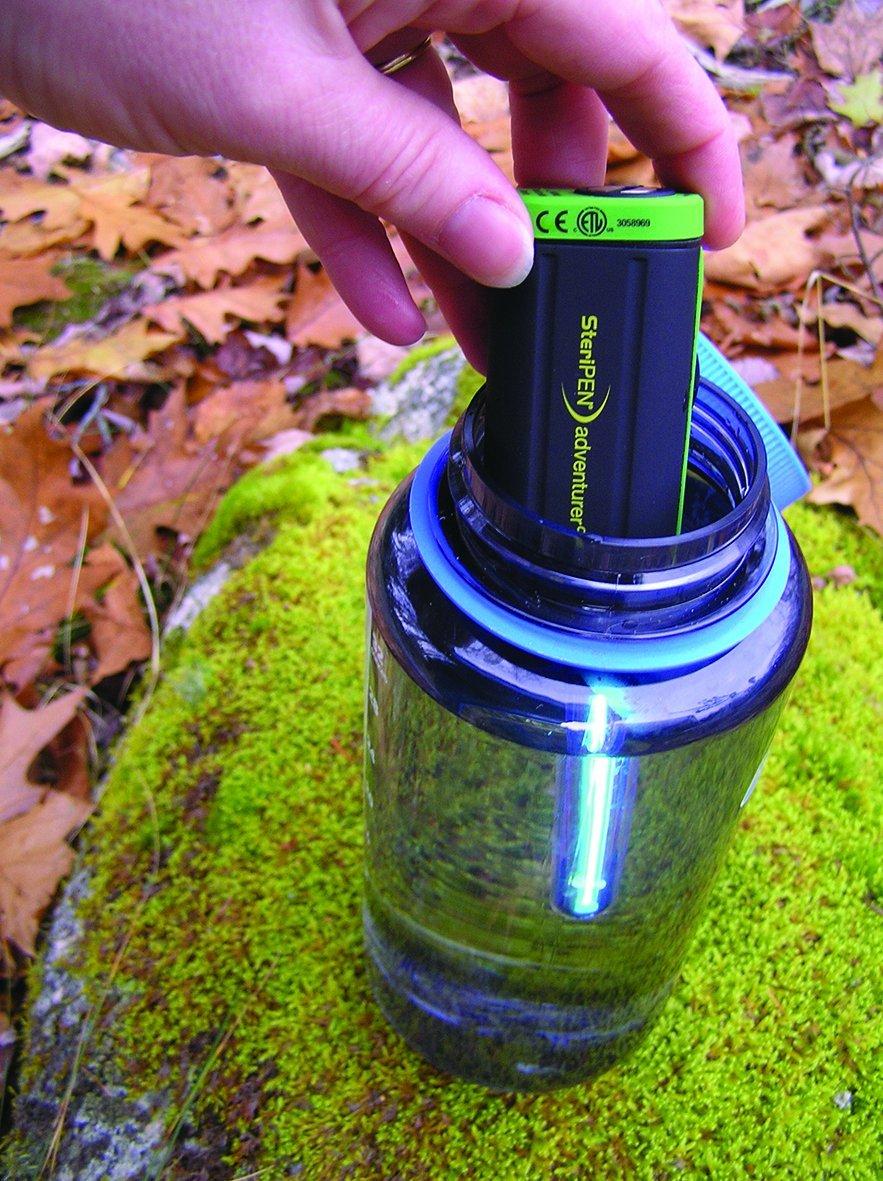
The beauty with Steripen devices is that their operation is relatively simple compared to other water purifiers. There is no physical effort (pumping, squeezing, pressing etc.) or chemicals involved .
However, if you’re purifying water that carries a lot of debris that’s very turbid, you should ensure you pre-filter the water before using the UV light to kill the pathogens.
UV rays will have better penetration in clear water and may not be able to effectively kill pathogens in murky water.
You can easily improvise a filter by placing a folded bandana over the mouth of your water bottle and then creating a small bowl-shaped depression in the cloth.
Slowly pour the water from another vessel into this depression and wait for the water to seep through the bandana into the bottle, thus removing any debris and most of the suspended material.
If you don’t have a bandana, another option is to use a coffee filter, or if you want to get a bit more fancy, the company also sells their own SteriPEN pre-filter.
The SteriPEN pre-filter has a 40-micron nylon mesh screen and screws onto your Nalgene or other wide-mouth water bottle, preventing particulates from entering the bottle while refilling.
To pass dirty water through the SteriPEN pre-filter you can either pour water from another container through the filter or you can submerse the whole thing in water (river, pond, lake etc.) while it's screwed onto the top of your water bottle.
In any case, once you have your vessel filled with clear water, you’ll then need to hold down the button on your SteriPEN until you see the green LED light flashing, indicating that the unit is ready to purify.
Pressing the button just once will ready the device to purify a litre of water, which will take approximately 90 seconds.
If you want to purify only ½ litre of water you need to press the button twice and the wait time will be approximately 48 seconds.
The reason it’s not one click for ½ litre and two clicks for 1 litre has to do with safety. If this was the case and a person mistakenly clicked the button only once when intending to purify 1 litre of water, the harmful pathogens might not all be deactivated.
The next step is to remove the protective cap from the UV bulb and submerge the bulb in the water. Once fully immersed the purification process should commence.
The device comes with an LED water sensor (which doubles as a flashlight), so that it only begins to emit UV rays once it’s submerged in the water.
A visible blue light inside the bulb shows that the UV light is working, though sometimes in the daytime this can be difficult to see.
The device should be gently agitated, stirred or twirled around inside the water while the purification process is underway.
The unit will switch itself off automatically after the correct dose of UV light has been applied, making it unnecessary to run a stopwatch or timer. The green LED light will appear to indicate that the process is done.
If you remove the device from the water during use it will immediately cease emitting UV radiation. Also, the rays can’t escape beyond the confines of the bottle so it’s perfectly safe to use.
Before you drink up, just give the threads, rim and lid of the bottle or vessel you’re using a good wipe with a bandana or micro-fibre towel to ensure you don’t ingest any contaminated water droplets along with the water you’ve just purified.
Most SteriPEN devices do not work well if the batteries get too cold so in very cold conditions you should warm the batteries in your hand or against your body if you want the device to work properly.
The UV light may also fail to turn on if the water you’re purifying is devoid of minerals or if the sensor doesn’t detect any minerals. This mechanism was designed to ensure that the UV light only turns on in water (since nearly all water contains trace minerals).
If you’re high in the mountains or trying to purify water from snowmelt this is often the case - such water is exceptionally pure since it hasn’t yet had a chance to run over rocks and riverbeds where it would accrue minerals.
Most of the newer Steripens have addressed this issue with more sensitive mineral detection sensors, but if you ever do experience it, all you have to do is drop a tiny pinch of salt or electrolyte powder into the water and the sensor should immediately detect it.
We mentioned earlier about how the optical sensor also serves as a flashlight, which comes in handy if you’re navigating to your water source at night.
To get the flashlight working, all you have to do is hold down the button for 3 seconds while the protective cap is on.
This will give you 3 minutes of light and the light can be re-activated as needed or turned off by pressing the button once.
You can refer to the Adventurer Opti user guide for more detailed instructions on using the device.
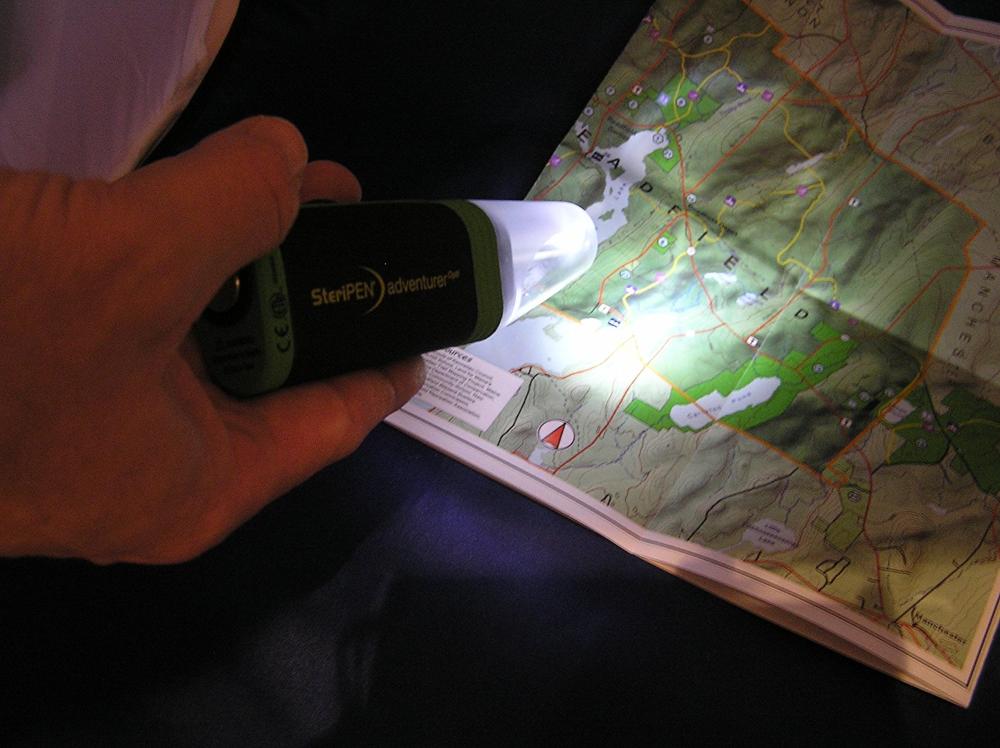
Value for money
The SteriPEN Opti Adventurer normal sells for around $90, giving us an initial cost per litre of about 1.125 cents.
However we also have to factor in the cost of replacing the lithium batteries every so often.
If a set of two batteries costs $3.90 (20-pack of Panasonic lithium CR- 123) and purifies 50 litres, that’s an extra $624 you’d have to spend on batteries to purify those 8,000 litres of water, which gives us a recurring cost per litre of 7.8 cents.
Taking everything into account, for the first 11 years, the cost works out at 8.925 cents per litre, which compares quite favourably with the other purifiers on our list.
Pros
- Fairly portable (compact and quite lightweight)
- Sturdy and durable
- Excellent lifespan (+ free replacement)
- Operation requires no physical effort
- Removes virtually all harmful microbes (including viruses)
- Works in virtually all environments, including cold ones
Cons
- Not an all-in-one solution (pre-filter and water bottle are separate components)
- Only works with vessels that have wide-mouth openings (1.75 inch minimum diameter)
- Won't remove tastes, odours, chemicals or heavy metals
- CR123 batteries are not widely available
- Wait time could be shorter
- Arguably replaces one form of pollution with another (i.e plastic waste with lithium batteries)
Is it for you?
We love the concept behind the Steripen - using powerful UV radiation to zap harmful microbes that might be lurking in the water. It’s an almost effortless way to render suspect water safe to drink.
While the Adventurer Opti is not an all-in-one solution, combining it with some kind of pre-filter to remove particulates and debris gives you a fairly complete travel water purification system with an impressive lifespan.
But if you’re looking for something that can handle chemicals or heavy metals, you'd want to check out one of the other purifiers that deals with these contaminants, because the Adventurer Opti doesn’t.
Because the batteries need frequent replacement, we’d say the Steripen would be ideal for short trips, but for an extended trip you might want to consider another option, unless you’re happy to carry around several sets of spare batteries.
For a less adventurous trip, where you think you'll have access to a wall outlet most of the time, there is also the USB rechargeable SteriPEN Freedom, which purifies 20 litres of water from a single charge.
This also treats 8,000 litres of water and is even smaller and lighter than the Adventurer Opti, weighing in at just 74 grams!
6. Aqua Pure Traveller
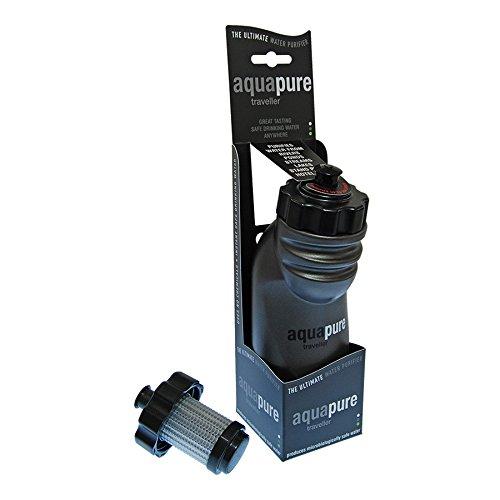
Specs
Dimensions: 8.7 x 3.2 x 2.8 inches (22 x 8.1 x 7.1 cm )
Weight: 120 g (6.4 oz)
Capacity: 600 ml
Flow rate: 1L/min
Purification method (s): Electro-adsorption, mechanical
Pore size: n/a
Removes: Viruses, bacteria, protozoa, chemicals, heavy metals
Filter lifespan: 350 L
Initial cost per litre: 14 cents
Recurring cost per litre: 13.5 cents
Like the LifeSaver and Grayl, the Aqua Pure Traveller is another water purifier-cum-water bottle, all-in-one solution for carrying, purifying and drinking water on the go.
But it’s a lot lighter (only 120 g) and much more compact than both of these systems and uses an even simpler system of water filtration and purification without requiring any pumps or moving parts.
This is actually the water purifier that we’re currently travelling with and have been successfully using for the past few years without any issues.
The Aqua Pure Traveller is manufactured by UK-based company, Pure Hydration.
The company was founded by Jon Grant in 1998, but has been developing innovative water treatment solutions since 1994, when Jon realized the need to reduce the environmental impact of disposable plastic water bottles in the workplace.
He successfully devised a commercial solution to this problem by developing a point of use (POU) system that would purify mains supplied water.
In 1995, his next invention in response to an urgent military requirement was the “Survivor 1” survival straw that was inserted in the US RAF aircrew combat survival waistcoat.
This device was in service 10 years before other manufacturers introduced straw-type filters and claimed that their products were the first of their kind available.
Pure Hydration continued to advance its understanding of individual water purification (IWP) devices and The first Aqua Pure Traveller™ was born in 1996 to purify suspect or untreated tap water.
A second version of the APT was then launched in 2001, which used a combination of carbon and iodine resin to remove viruses from water, a task many filters today still fail to accomplish.
The final leap forward occurred in 2011 with the introduction of Pure Hydration’s 3rd generation purification technology MAD® (Mechanically Advanced Disinfection), which eliminated the need to use iodine to remove viruses from the water.
The Aqua Pure Traveller has been endorsed by the Hospital for Tropical Diseases in London, and has passed independent laboratory testing to NSF-ANSI 42 and NSF-ANSI 53 standards.
It has also been tested to the EPA Microbiological Guide Standard & Protocol for Testing Microbiological Water Purifiers in the UK and in USA.
You can learn more about the company and its origins on its about page.
Product description
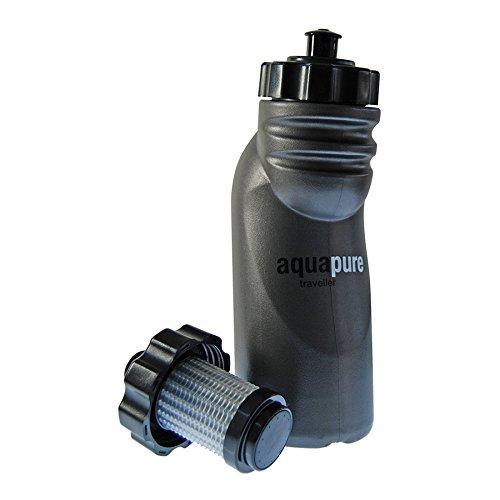
The Aqua Pure Traveller very simply comprises of just two pieces, a water bottle made from a soft, flexible plastic and a screw-top cap with a plastic pop-up teat and an attached filter.
The filter cartridge is fused seamlessly to the underside of the screw-top cap and the unit is designed in such a way that all the water inside the bottle must first pass the purification unit before it can exit through the plastic teat into your mouth or into a collecting vessel, so it’s pretty idiot-proof.
The bottle itself is made of soft squeezable plastic and has an unusual shape, though it still manages to stand up on a flat surface without tipping over. The two ribs at the top help to improve grip.
The stated capacity of the bottle is 700 ml, but in practice we were only able to squeeze about 600 ml of water out of the bottle when it was filled right to the brim.
A few millilitres of water will always remain in the bottle at the end that you won’t be able to squeeze out through the filter.
For an extra few bucks you can also buy a neoprene carry case for the Aqua Pure Traveller so that you can protect it from accidental knocks and drops on the road. Remember that the bottle isn’t exactly made from the sturdiest plastic.
The neoprene material acts as an insulator and helps to keep your water cool, while the individual stitched panels allow for a skin-tight fit with your bottle.
The case comes in three colour options and also has an attached trigger clip, carabiner and belt loop, allowing you to easily clip it onto a belt, backpack, rucksack or whatever, thus keeping your hands free while carrying the bottle.
This would be very useful if your backpack doesn’t have netted side pouches or if you’re carrying electronics or other sensitive items and can’t risk keeping the water bottle inside your backpack in case it leaks.
Overall, we’d have to say that the Aqua Pure Traveller is a very dependable and effective water purifier, and after drinking dubious water from the bottle on a frequent basis over the past years, it has never once made us sick.
We’ve used it while scaling mountains, during long-distance treks in the wilderness, when camping in national parks, for purifying regular tap water in India and Southeast Asia, for sterilizing free water in restaurants with questionable hygiene standards, and for many other applications.
One thing we would like to point out is that, although we never experienced any leakage from the screw-on cap, after using this water bottle for a few years we began to notice some erosion of the plastic around the water exit hole at the top of the nozzle.
Because of this the nozzle now leaks when the bottle is not kept in an upright position, even if the nozzle is pushed down in the “closed” position.
This gradual erosion over time might have been avoided if the bottle came with some kind of a protective cap or cover for the nozzle, which would also have helped to keep out dust, dirt and other contaminants.
The Aqua Pure Traveller comes with a 30-day refund or replacement guarantee if you are not 100% satisfied with the product and you also have a 1-year warranty against manufacturing defects.
The filter
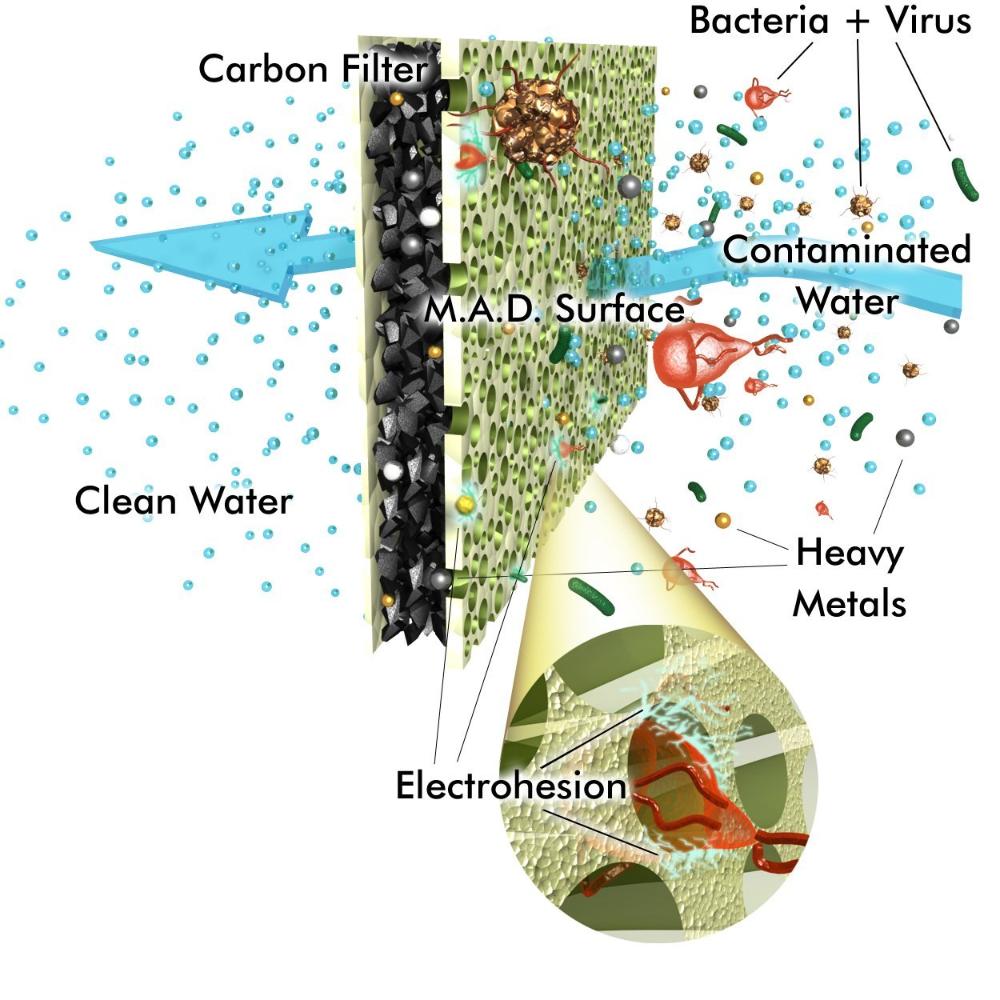
The filtration unit uses a technology known as M.A.D (Mechanically Advanced Disinfection), which is partially based on a phenomenon known as electro-adsorption.
How M.A.D works is that positively charged nano alumina fibres inside the filter remove negatively charged viruses and other microbes from the water via electro-adhesion. The larger bacteria and protozoa are also partially removed by this process but also by mechanical action.
The filter also employs powdered activated carbon (PAC) and anti-microbial silver impregnated zeolites, in addition to 400 layers of pores.
Despite the simplicity of the overall product, the filter is highly sophisticated and will remove 99.9999% of bacteria, 99.999% of viruses, more than 99.99% of larger pathogens and more than 99.9% of many heavy metals, chemicals, dirt and odour.
It goes without saying that it’ll also filter out larger debris like twigs, sand, leaves and so on. The outflow from the nozzle is always crystal clear, pure H20, even when the original water source is full of silt, mud or debris.
The purifier has also been proven to reduce levels of more than 100 different types of contaminants including heavy metals (such as mercury, cadmium, lead, arsenic etc.), pesticides, aromatic hydrocarbons (e.g benzene, toluene), PCBs, and other hazardous chemicals, by more than 99.9%. Fluoride tested to NSF-53 standard was reduced by 95%.
Protection from chemicals is really important when travelling in developing countries and even in some developed countries, as industrial waste like PCBs (polychlorinated biphenyls) is often being piped directly into rivers.
These PCBs are particularly insidious and have even been found in birds and fish in the arctic because of the ocean currents.
Heavy metals like cadmium, lead and mercury are also ending up in many rivers and water bodies from manifold sources, including old batteries and discarded electronic equipment.
You can view the chemical test report and microbiological test report for the Aqua Pure Traveller on the company’s website.
The integrated filter will process up to 350 litres of water before expiring and needing to be replaced.
With this filter, assuming you use it to drink 2 litres of water a day on average, it should last you about 175 days (almost 6 months).
If your trip will last longer than 6 months you should probably purchase a spare filter or two in case you have difficulty getting them delivered when you’re on the road.
Replacement filters are often unavailable on Amazon.com but on Amazon.co.uk a replacement filter will normally set you back about £35, which is almost as expensive as buying the product brand new again.
You can maximize the filter lifespan by avoiding turbid or muddy water sources whenever possible, or by pre-filtering murky water with a bandana or t-shirt, as small particulates will prematurely block the filter.
Don’t worry about drinking contaminated water once the filter expires because the Aqua Pure Traveller has a failsafe mechanism where the filter will simply stop passing water when that day comes.
Before the water flow is completely cut off it will get gradually harder to squeeze water through the filter.
Even though there is no risk in using the filter until it stops working, the company recommends that you replace the filter after one year of use for optimum performance.
Note that once the filter has been wetted it is susceptible to freezing and should be replaced if you suspect it has been frozen.
Operation
.jpg)
Operation of the Aqua Pure Traveller is simple and requires no pumping mechanism, though it does require a small amount of physical effort to squeeze out the water with your hands.
The first step is to unscrew the mouthpiece, set it aside carefully away from the suspect water, and then fill the bottle with the water you want to filter, as you would do with any regular water bottle.
The mouth of the bottle is reasonably wide, which definitely makes the bottle easier to fill it from ponds, puddles, lakes and rivers.
As for how to fill it, you can get away with dunking the bottle into a water source, because the cap is only screwed back on after the bottle has been filled, so unpurified water shouldn’t ever contaminate the drinking nozzle area.
If the water is really cloudy, dirty or full of large debris we’d recommend pre-filtering it first (a bandana or other piece of fabric would do just fine), because the less your filter has to work, the longer it’ll last and the more litres of water it will purify for you before it expires.
Once the bottle is filled (leave a little air space at the top because the filter displaces some water when it’s inserted), just screw the cap back on, pull up the pop top (nozzle) to the open position, turn the bottle upside down and start squeezing the sides of the unit with both hands to begin the outflow of purified, crystal clear water from the nozzle.
This is the part that can get a little tedious and repetitive, though you don’t have to squeeze super hard to get the water to start flowing from the nozzle.
With each squeeze a finite volume of water will be expelled from the nozzle, so you’ll have to perform multiple squeezes to completely empty the bottle.
In our testing it took 5 or 6 hard, long-lasting squeezes to completely discharge the bottle from filled to the brim and we were able to dispense 600 ml of water in about 50 seconds.
With a newer filter you might be able to achieve the advertised flow rate of 500 ml in 30 seconds.
You can squeeze the purified water directly into your mouth or into another collecting vessel if you’d rather not drink directly from the plastic bottle.
You can also use the water to irrigate wounds, brush your teeth, wash fruit and vegetables, make tea, cook etc.
Because of its sheer simplicity, this is a very low-maintenance water purifier and the only upkeep we have to do is to occasionally give the bottle a wash with warm soapy water and give the filter a good rinse with tap water.
The plastic of the bottle itself is also impregnated with an anti-microbial, which prevents viruses and bacteria from surviving on the surface of the bottle.
There are no moving parts or pumping mechanisms so you don’t have to re-apply grease or lube periodically, as is the case with many other water purifiers.
Value for money
So is the Aqua Pure Traveller good value for money? The company claims that 350 bottles of water (1L) would cost you on average £245 worldwide.
The product normally sells for about £40 on Amazon UK so if that is true you would save around £205 by using the Aqua Pure Traveller instead.
But what we really should be asking is how it stacks up against other water purifiers in terms of cost per litre.
Given that the product normally sells on Amazon.com for about $50 and filters 350 litres, the initial cost per litre for the Aqua Pure Traveller actually works out at about 14 cents.
Replacement filters are almost as expensive as buying the whole thing again, so the cost per litre only drops to about 13.5 cents after you go through the first filter.
This is definitely on the higher end as far as water purifiers go, though the Aqua Pure Traveller does promise to remove virtually everything (viruses, bacteria, protozoa, chemicals, heavy metals, tastes, odours), and it is a very convenient, lightweight, all-in-one water purification solution.
Pros
- Very simple (no batteries, pumps, chemicals, attachments)
- Super portable (compact & lightweight)
- Removes virtually everything
Cons
- Filter lifespan is relatively short
- Bottle capacity could be greater
- Operation requires some physical effort (squeezing)
- Filter is vulnerable to freezing
- Cost per litre is quite high
Is it for you?
If you’re looking for an ultra-portable, easy-to-operate, all-in-one water purification solution that removes virtually every type of waterborne contamination, it’s very difficult to beat the Aqua Pure Traveller.
We’d like if it could hold a little more water, the filter lifespan could be improved, and a cap to cover the drinking spout would be nice, but overall, we think that this water purification bottle outclasses its rivals.
For us at least, it checks all the critical boxes and that is the reason this was the water purifier bottle that we personally chose to travel with, and not any other.
7. Water-to-Go Filter Bottle
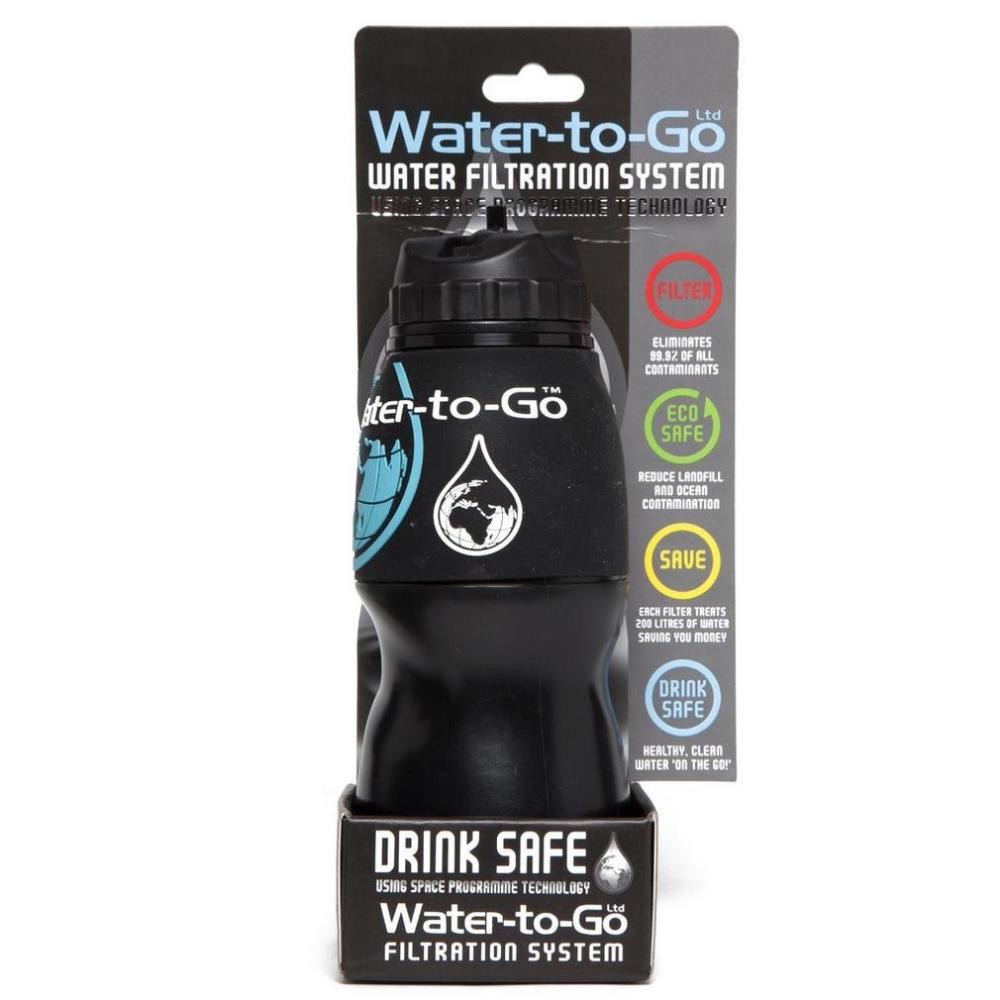
Specs
Dimensions: 10.2 x 3.5 x 3.5 inches
Weight: 138 g (empty with dry filter), GOI bottle weighs 98 g
Capacity: 750 ml
Colour: Black, green, blue, desert, jungle, pink, red
Flow rate: 0.6 L / minute (10-12 ml/s)
Purification method(s): Mechanical, Electro-adsorption, Activated carbon
Pore size: 0.7 microns
Removes: Viruses, bacteria, protozoa, heavy metals, chemicals
Filter Lifespan: 200 litres
Initial cost per litre: 20 cents
Recurring cost per litre: 7.5 cents
The Water To Go Filter Bottle is another water bottle with an integrated purification cartridge that claims to be based on technology originally built for the NASA Space Programme.
Like the Aqua Pure Traveller, LifeSaver and the Grayl, this is a complete water purification solution that’s ideal for every conceivable travel scenario or activity – jungle trekking, hiking, camping, rural areas, cities, urban survival etc,
Water To Go is the brainchild of Dave Shanks and co-founder Cheryl Farrell, who formerly headed a textiles company that manufactured and distributed clothing brands across the globe.
Dave used to make frequent trips to India, China and Indonesia and was appalled to see so much plastic waste in the industrial areas he visited, and he noticed that the chief offender was usually single-use plastic bottles.
Dave and Cheryl have strong humanitarian and environmental motivations underpinning their product.
Their vision is that their product will provide the world with safe, clean, affordable drinking water and will help reduce the damage done to the environment by single-use plastic water bottles.
The company is UK based, but have a number of distributors all around the world, so wherever you are located, Water To Go will work for you.
The filter membranes are manufactured in the USA and all the other parts are assembled in Water To Go units in Thailand.
The Water To Go Filter Bottle shares quite a few similarities with the Aqua Pure Traveller, but there are also a few important differences, as we shall now see.
Product description
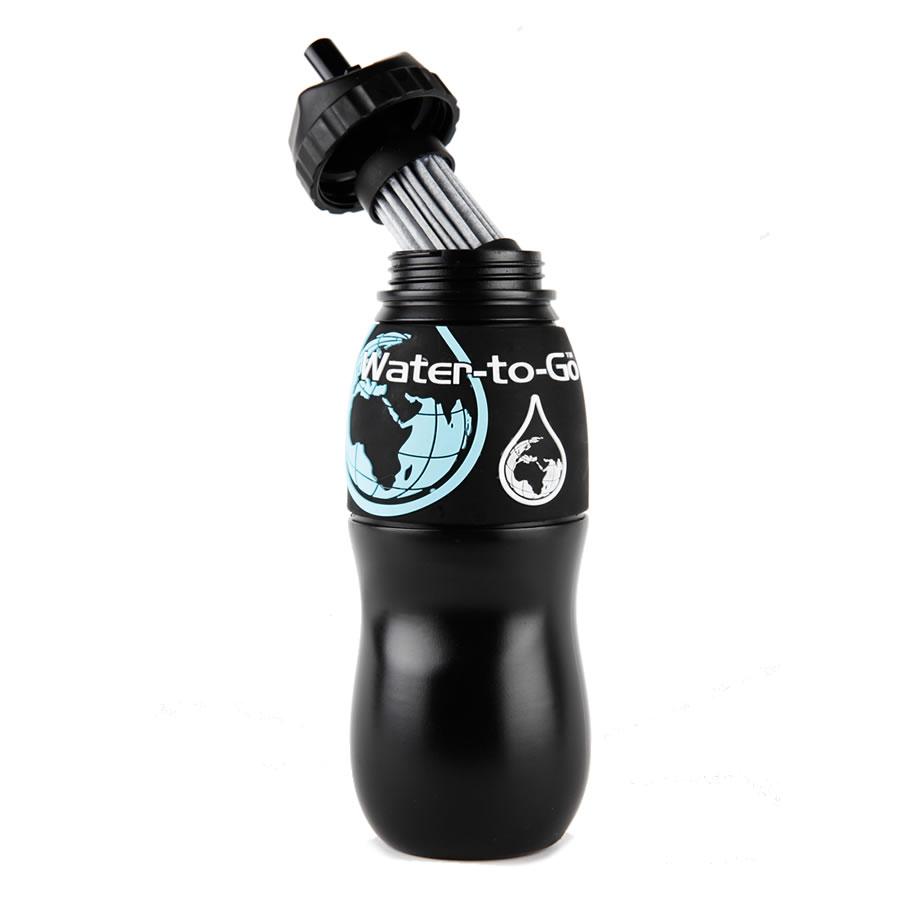
At 10 inches tall, 3.5 inches in diameter and weighing in at 138 g, The Water To Go Filter Bottle is taller, bulkier and slightly heavier water filter bottle than the Aqua Pure Traveller, with a less unusual shape for a water bottle.
Despite being somewhat bulky, the Water To Go bottle should still fit in the side mesh pockets of most backpacks, so carrying it shouldn’t be an issue.
The bottle is dishwasher safe, BPA-free, and is made from LDPE (low-density polyethylene), a specially developed thermoplastic that’s approved by the FDA for food and beverages.
The bottle itself is black but has a rubber sleeve near the top that comes in a range of different colours including black, green, blue, desert, jungle, red and pink.
The capacity of the bottle is 750 ml, which hits the sweet spot for travel in our opinion, being a happy medium between portability and enough water to tide you over between most refill points.
Like the Aqua Pure Traveller, the Water To Go Filter Bottle is designed to be used with a replaceable filter that is attached to the underside of the screw-top bottle cap, but it has a flip-out drinking spout instead of a pop-top teat.
The filter
.jpg)
The 3-in-1 Water To Go filter uniquely employs three different technologies to remove virtually all types of contaminants from the water you’re filtering, including microbiological agents, hazardous chemicals and heavy metals.
The three technologies used are mechanical filtration, electro-adhesion and activated carbon, which is incorporated into the filter membrane.
As regards mechanical filtration, the filter uses a pore size of 0.7 microns, which isn’t very small compared to some other purifiers.
But this filter combines three different technologies to remove contaminants, so it doesn’t depend on having a miniscule pore size for its efficacy.
The filter seems to employ the same electro-adsorption principle that is used in the Aqua Pure Traveller filter to remove viruses, bacteria and protozoa from the water.
From the website:
“The 3-in-1 system in our filters was developed at the behest of NASA and they are constructed utilizing nano technology. Nano alumina along with activated carbon and other filtration ingredients are utilized to bring about this amazing new patented process. The nano alumina emits a positive charge when wet and attracts the negatively charged contaminants of protozoa, bacteria and virus.”
The activated carbon used in the Water To Go filter is not of the inefficient carbon block type, where up to 70% of the surface area is lost by the adhesives that are used to hold the block together.
Such carbon block filters also have a larger pore size that doesn’t remove harmful microbiological contaminants like viruses, bacteria and protozoa.
Instead of using a carbon block filter, Water-to-Go incorporates the activated carbon into the filter membrane for greater improvement of taste and greater odour reduction.
The 3-in-1 filter will remove 99.9% of all contaminants, including viruses like Hepatitis A and Polio, bacteria like Cholera and E.Coli, protozoa like Cryptosporidium and Giardia Lamblia, heavy metals like lead and mercury, hazardous chemicals like chlorine and fluoride, parasitic worms like tapeworm and threadworm, and microplastics.
There’s a longer list of the nasty stuff that the filter removes on the company’s website. They mention on this same page that the Water To Go filter will not remove Arsenic to 99, presumably meaning 99%.
The filter has been tested extensively in three different countries (UK, USA and India) and all have confirmed that the Water To Go filter removes more than 99.9% of contaminants in water.
In the UK the filter has been subjected to testing by The London School of Hygiene & Tropical Medicine. You can view the testing data for that here.
In the USA it has been tested by BSC laboratories in Gainesville, Florida and you can view the testing data for that here.
In India, Water To Go was tested by Bangalore Test House. You can view the results here.
The filter that comes with the Water To Go bottle needs to be replaced after filtering 200 litres of water. You can normally buy a twin pack of replacement filters on Amazon for about $30.
Assuming you drink 2 litres of water from the bottle per day, it’s going to last you about 100 days or a little over 3 months, so you’ll need to bring a few replacement filters if you’re planning a longer trip.
Something that concerns us is that the filter doesn’t have a proper failsafe mechanism that shuts off the water flow when you surpass this limit, as do some of its rivals.
Instead, they’ve programmed just enough carbon into the 3-in-1 filter unit that it stops filtering odours and tastes after processing 200 litres of water.
The filter will continue to remove harmful microbiological contaminants for another 30-50 litres after you’ve passed the 200 litre mark, the idea being that before you exceed the lifespan you will have noticed a change in odour and taste in the water, which will prompt you to change the filter.
But what if you’re travelling and constantly drinking from different water sources, and you’re not sure what the water “usually” tastes like when the carbon filter is working? This definitely concerns us.
However there is another way that you can know when to change the filter; if you have registered with Water To Go you will be then be sent a reminder e-mail that it’s time to change the filter after 3 months.
But then what if you aren’t using the bottle regularly during those 3 months?
Because of these imperfect solutions, feel that the best way for you to know when to change the filter will be for you to record your usage.
Like most filters, the Water to Go is not recommended for filtering juice, squash, cordial, sea water or (God forbid) urine, as other liquids will reduce the efficiency and lifespan of the filter (and seawater will probably destroy it).
The filter can withstand fridge-level temperatures but if it freezes the membrane will be damaged, its performance impaired, and the filter will need to be replaced ASAP.
Operation
When you are using your Water To Go filter for the first time or whenever you’re replacing a spent filter you must “activate” the new filter.
To activate, first wet the new filter by immersing it in water (either clean or contaminated water) for about 15-20 minutes.
It’s recommended you do this by first filling the bottle with water and then turning it upside down. You should then flush the filter fully one time until the water runs clear, and then discard this first batch of filtered water. The second batch of filtered water is fully drinkable.
Note that if you don’t use the water bottle for a while and the filter dries out it will need to be reactivated in the same manner again before use.
Normal operation of the Water To Go is much like that of the Aqua Pure Traveller but with one important difference.
After you’ve filled the bottle with the suspect water and screwed the cap tightly back in place (but don’t overtighten), you can then either squeeze the sides of the bottle if you want to fill a vessel with the purified water, or suck the water directly into your mouth from the spout as you would do with a normal sports bottle.
The flow rate seems to be rather poor when trying to squeeze out the water however, and you get a much better flow rate of about 10 ml/s when you just suck directly from the spout.
This does mean that it’s not a great option if you like to cook with filtered water, as it’ll be time-consuming to squeeze the water out into a saucepan. It also means that it won’t be great for irrigating wounds or washing fruit and vegetables.
Don’t try to increase the flow rate by squeezing the bottle really hard, as this could, in extreme cases, result in a gap forming between the bottle and the lid, possibly allowing contaminated water to bypass the filter.
Pros
- Capacity is pretty ideal
- All-in-one solution
- Good value for money
Cons
- Filter failsafe mechanism isn't confidence-inspiring
- Not designed for squeezing
- Filter lifespan is relatively short
- Might be a little bulky for some
Is it for you?
Compared with the Aqua Pure Traveller, the Water To Go Filter bottle has a more ideal water holding capacity and a lower recurring cost per litre (due to the cheaper replacement filters).
However it’s bulkier, slightly heavier, the filter lifespan is a lot shorter and you don’t get a great flow rate when you squeeze the bottle.
Perhaps most worryingly though, the Water To Go bottle doesn’t have a very confidence-inspiring filter failsafe mechanism, which the Aqua Pure Traveller does.
Overall it’s quite a close call between these two water purifiers and your decision will depend very much on your personal priorities and taste, but for us, it’s the Aqua Pure Traveller.
Conclusion
There is no one universal water purifier that’s perfectly suited to every traveller.
Factors like trip duration, style of travel, the countries you’re visiting, whether you’re going off-grid or not, your budget and tons of others come into play when making a decision.
In this article we’ve fully reviewed the top 7 water purifiers for the purpose of travel and suggested a few additional related products as well.
We hope we’ve provided you with enough information for you to be able to come to a final decision about what water purifier you’re going to buy.
If you enjoyed this article, please share it with other travellers. Do you have any recommendations that we didn’t mention in this article? What water purifier are you currently travelling with or have you travelled with in the past? Let us know your thoughts in the comment section below!
JOIN OUR LIST
SUPPORT US
FOLLOW US
ABOUT US
Our names are Eoghan and Jili and we hail from Ireland and India respectively.
We are two ardent shoestring budget adventure travellers and have been travelling throughout Asia continuously for the past few years.
Having accrued such a wealth of stories and knowledge from our extraordinary and transformative journey, our mission is now to share everything we've experienced and all of the lessons we've learned with our readers.
Do make sure to subscribe above in order to receive our free e-mail updates and exclusive travel tips & hints. If you would like to learn more about our story, philosophy and mission, please visit our about page.
Never stop travelling!
FOLLOW US ON FACEBOOK
FOLLOW US ON PINTEREST
-lw-scaled.png.png)

